
Annex 5
Narrative Interim Report
The report must describe in detail how the project has progressed and the results achieved so far, and must
describe how the project funds have been used for the planned activities. The total length should not exceed
15 pages.
BMZ Project number:6815
Project country:South Africa
Project title: Community-Based Adaptation to Climate Change (CBCCA) to build resilience
Organisation: Mahlathini Development Foundation(MDF)
Project duration: 01.10.2022 bis 31.08.2025
1.GeneralInformation
The CbCCA project is based on working with Climate resilientAgriculture(CRA)learning groupsof smallholder
participants. These groupsare set up a at village level across three provinces:KZN, EC and Limpopo.They work
on an annualcyclicalplanning andreviewprocess for implementationof CRApractices(Field cropping,
homestead food productionandlivestock management) –which are supportedthrough training, mentoring
andimplementationsupport. The intentionisto support both existing learning groupsin the three provinces to
deepen their implementationand to initiate new learning groups.
Figure 1: Map of SODI-CbCCA villages across EC, KZn and Limpopo
CRA learning groupmembers alsoundertakea rangeof other associatedactivitiesaccordingto their need,
meaning that not all groups undertake the same activities:

Project no 2116ZA311
2
ØSetting up and running villagesavings andloanassociations (VSLAs), with membership from the CRA
learning groups andbeyond, for savingsand small loans for consumptionsmoothing and productive
activities
ØEnterprise developmentandlocal marketing committees andgroups, mostlyto run the joint monthly
produce markets in nearby towns, but also includes egg and broiler production and sales, livestock
auctionsandmore formal market contracts
ØWater access and management through water committees linked to local governance structures, for
planning and implementingintegrated water management activitiesand
ØLivestock committees, for developmentof conservationagreements for rangeland management and
local livestock auctions
The diagram below indicates theinteractions with these local or micro level groups at themeso- levelthrough
clusters andplatforms with multiple stakeholders and at the meso- and macro level through more formalized
organizationalforumsand networks.
Figure 2: The micro-, meso- and macro-level interactions for the CbCCA programmeand the Communities of
Practice(COPs).
Quarterly project reports outline the trainings undertaken,field-basedactivities undertaken with theCRA
learning groupsandtheirprogress relatedtoeconomic empowerment (VSLAs, marketing etc.). informationon
activitiesrelated tothe innovation and multistakeholder platforms is also to be included in summary form.
Integrated water and natural resourcesmanagement activities are more discreet in nature andwill be reported
on as progress is made. This also applies tothe development of evidence-basedindicators andthe monitoring
andevaluation handbook development
1.1.Project Description/ Project Objectives
The COVID-19 pandemic, global economic downturnsand internal political and economicinstabilityhave
exacerbated the already significantnegativeimpactof climatechange on smallholder farmercommunities in
South Africa.Unemployment is very high(60-80%), with very low incomes primarily through social grants
(around r2000/month per householdof 4-5 members). Smallholders need tofind ways to provide for a
sustainable livelihoodfor themselves through farming andresourceuse in theirvillages.The climateresilient
agriculturepractices have bene piloted andhave been shown to significantly improve both livelihoodsand
social agency and now needs tobe deepenedand expanded.
The project objectivesand outputs are summarized in the small table below.

Project no 2116ZA311
3
Overall objective
(impact)
Communities have improved their livelihoodsandtheir capacity to adapt to climate change and
have strengthened their resilience climate change risks and shocks
Project
outputs/objectives
O1
Capacity is developed for creation of and strengthening institutional frameworksand
mechanisms for including proven multi-benefit approaches that promote collective action and
coherent Community based Climate Change Adaptation (CbCCA) implementation.
O2
The farmer level decision support system for implementation of CRA is upscaled in eastern SA.
O3
Appropriate frameworks for monitoring and evaluation of environmental benefits and agro-
ecosystem resilience are developed at multiple scales
O4
Improvement of waterand natural resources management and governance through
community ownership
1.2.Source ofInformation
Each activity set within the project has a focused monitoringand evaluation process, to encompass the range
of environmental, agricultural, economic and social indicators used for reporting.Monitoring forms include for
example the CCA base lines, Crop and garden monitoring, poultry production monitoringand fodder
supplementation monitoring. Databases are collated for themonthly VSLA(villagesavings andloan
associations) recordsandmonthly market stall sales andincomes. Seasonal reviews for each learning group
consists of focus groupdiscussions andindividualinterviews.Resiliencesnapshots and participatoryimpact
assessments provide more summativeevaluativecontent.
In addition, the provincial field team leaders (Betty Maimela and Mazwi Dlamini) providemonthly reportson
trainingand implementation undertaken with theCRA learning groups.Photographsare included in these
summariesandattendance registers are available. All interns are expected to provide monthly field work
reports(for SODI – Sphumelelo Mbhele)and reports for events,workshops andmeetings are submitted.
Erna Kruger uses these reports and databases to compile the SODI quarterly reports fortheorganization.
Financialreportsre compiled jointly by Erna Kruger and SarikaRamsewak.
2.Project Status
OverallObjective(Impact):Communities are empowered to adapt to climate change and their resilience is
strengthened.
Project Objective
(Outcome):
Indicator
Base value
(quantitative & qualitative)
Equivalent to proposal
Target value
(Quantitative & qualitative)
Equivalent to proposal
Achievements
(quantitative & qualitative)
Smallholder families in 3
provinces in South Africa
apply climate-adapted
agricultural practices and
diversify their income
opportunities in order to
stabilize food security in
the long term.
As part of an MDF pilot
project, 345 smallholder
farmers have gained
initial experience with
local agricultural practices
for climate change
adaptation. There is
currently no coherent
regional or local system
for climate-adapted
agriculture bysmallholder
farmers.
2,625 beneficiaries of
smallholder farming
families and 75
stakeholders in 3 provinces
are organized in
Communities of Practice
(CoP) and implement at
least 3practices for
climate-adapted agriculture
according to developed
standards.
239 participants (956
beneficiaries)
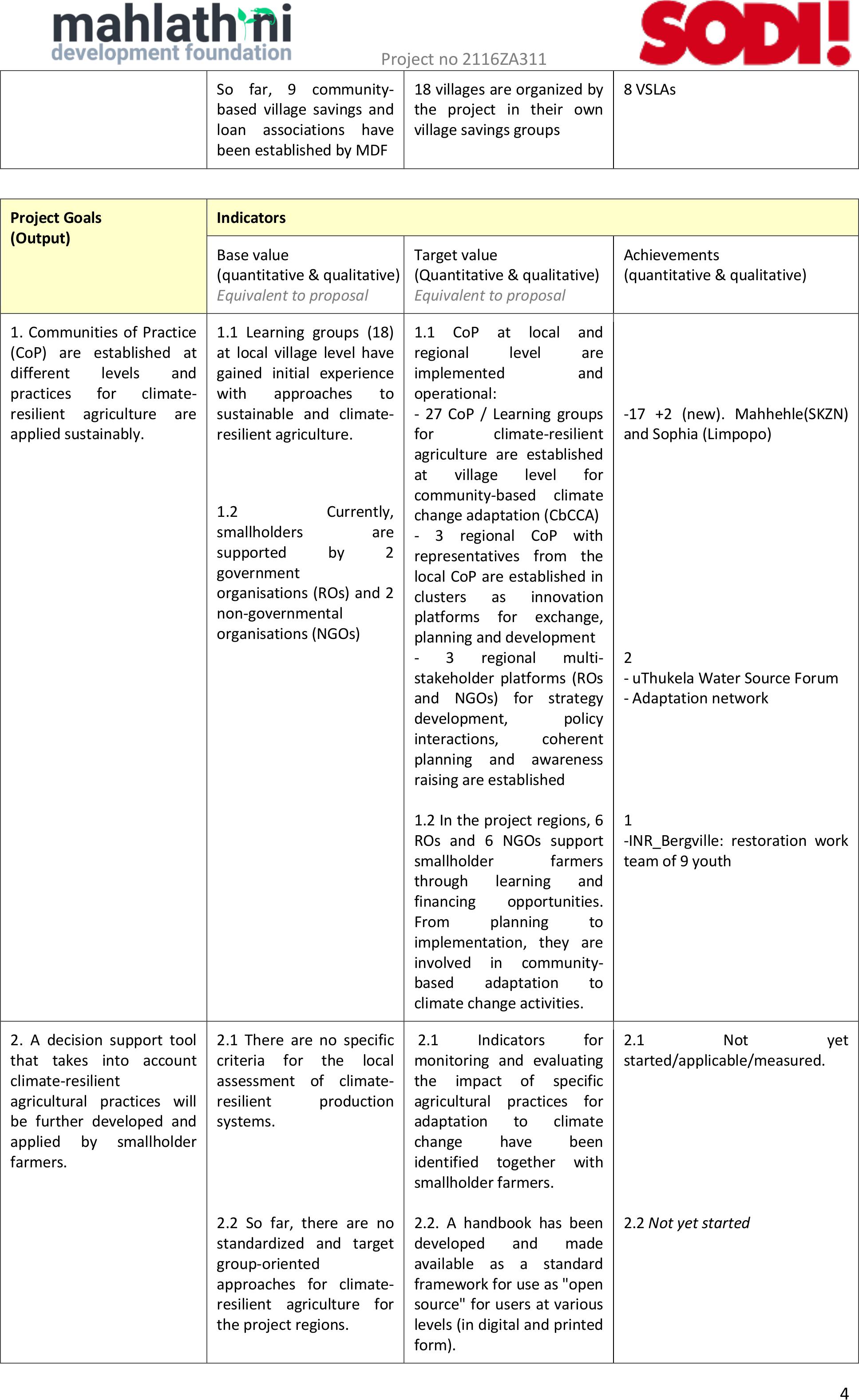
Project no 2116ZA311
4
Project Goals
(Output)
Indicators
Base value
(quantitative& qualitative)
Equivalent to proposal
Target value
(Quantitative & qualitative)
Equivalentto proposal
Achievements
(quantitative & qualitative)
1. Communities of Practice
(CoP) are established at
different levels and
practices for climate-
resilient agriculture are
applied sustainably.
1.1 Learning groups (18)
at local village level have
gained initial experience
with approaches to
sustainable and climate-
resilient agriculture.
1.2 Currently,
smallholders are
supported by 2
government
organisations (ROs)and 2
non-governmental
organisations (NGOs)
1.1 CoP at local and
regional level are
implemented and
operational:
- 27 CoP / Learning groups
for climate-resilient
agriculture are established
at village level for
community-based climate
change adaptation(CbCCA)
- 3 regionalCoP with
representativesfrom the
local CoP are establishedin
clustersas innovation
platforms for exchange,
planning and development
- 3 regional multi-
stakeholder platforms (ROs
and NGOs) for strategy
development, policy
interactions, coherent
planning and awareness
raising are established
1.2 In the project regions, 6
ROs and 6 NGOs support
smallholder farmers
through learning and
financing opportunities.
From planning to
implementation, theyare
involved in community-
based adaptationto
climate change activities.
-17 +2(new). Mahhehle(SKZN)
and Sophia (Limpopo)
2
- uThukela Water Source Forum
- Adaptation network
1
-INR_Bergville: restorationwork
team of9 youth
2. A decision support tool
that takes into account
climate-resilient
agricultural practices will
be further developed and
applied by smallholder
farmers.
2.1 There are no specific
criteria for the local
assessment of climate-
resilient production
systems.
2.2 So far,there are no
standardizedand target
group-oriented
approaches for climate-
resilient agriculture for
the project regions.
2.1 Indicators for
monitoring and evaluating
the impact of specific
agricultural practices for
adaptation to climate
change have been
identified together with
smallholder farmers.
2.2. A handbook has been
developed and made
available as a standard
framework for use as "open
source" for users at various
levels(in digital and printed
form).
2.1 Not yet
started/applicable/measured.
2.2 Not yet started
So far, 9 community-
based village savings and
loanassociationshave
been established by MDF
18 villagesare organized by
the project in their own
village savings groups
8 VSLAs
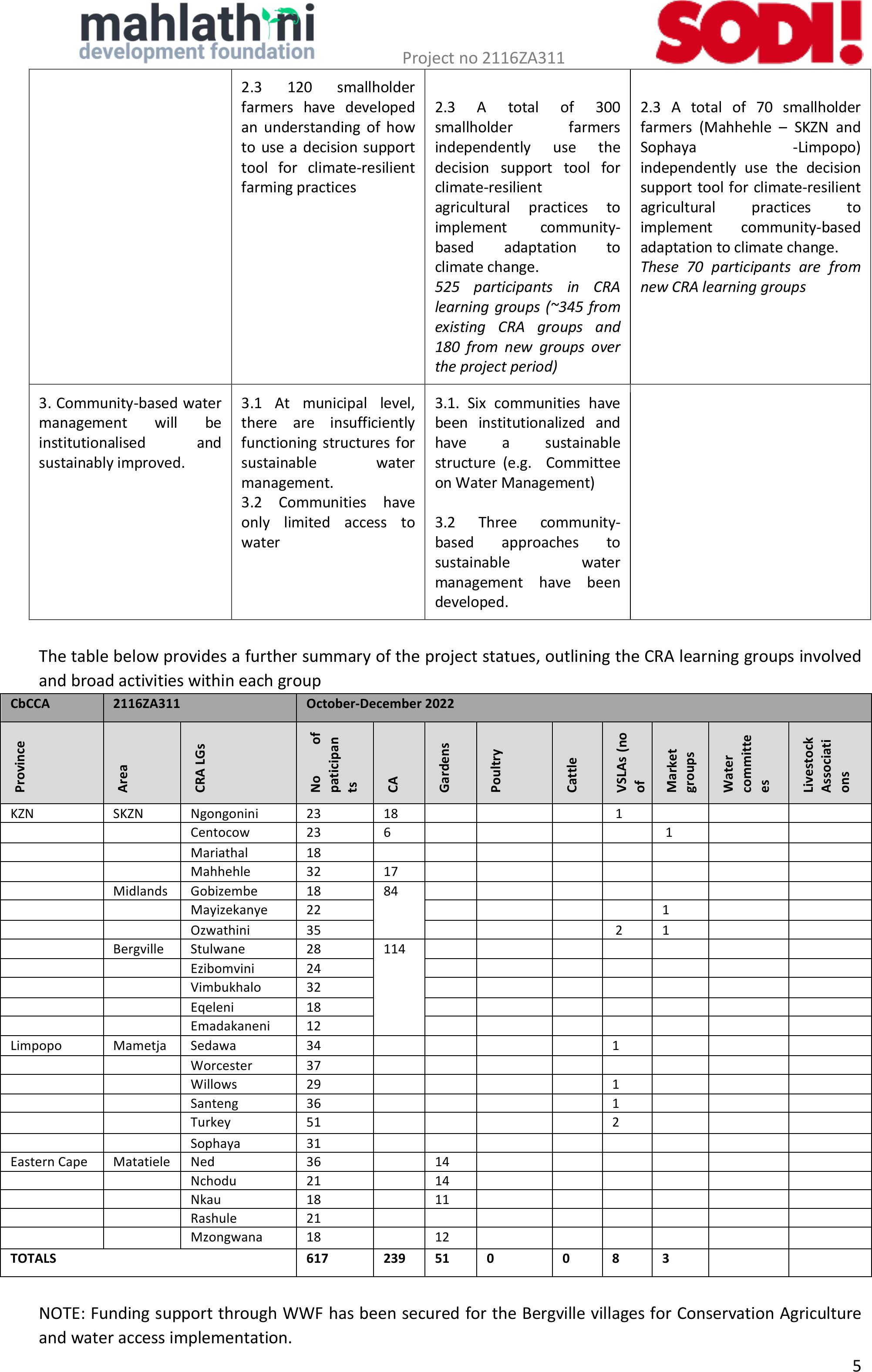
Project no 2116ZA311
5
2.3 120 smallholder
farmers have developed
an understanding of how
to use a decision support
tool for climate-resilient
farming practices
2.3 A total of 300
smallholder farmers
independently use the
decision support tool for
climate-resilient
agricultural practices to
implement community-
based adaptation to
climate change.
525 participants in CRA
learning groups(~345 from
existing CRA groups and
180 from new groups over
the project period)
2.3 A total of70 smallholder
farmers (Mahhehle – SKZN and
Sophaya -Limpopo)
independently use the decision
support tool for climate-resilient
agricultural practices to
implement community-based
adaptation to climate change.
These 70 participants are from
new CRA learning groups
3. Community-based water
management will be
institutionalised and
sustainably improved.
3.1 At municipal level,
there are insufficiently
functioning structures for
sustainable water
management.
3.2 Communities have
only limited access to
water
3.1. Six communitieshave
been institutionalized and
have a sustainable
structure (e.g. Committee
on Water Management)
3.2 Three community-
based approaches to
sustainable water
managementhave been
developed.
The table belowprovides afurthersummary of the project statues, outlining the CRA learning groups involved
and broad activities withineach group
CbCCA
2116ZA311
October-December 2022
Province
Area
CRA LGs
No of
paticipan
ts
CA
Gardens
Poultry
Cattle
VSLAs(no
of
groups)
Market
groups
Water
committe
es
Livestock
Associati
ons
KZN
SKZN
Ngongonini
23
18
1
Centocow
23
6
1
Mariathal
18
Mahhehle
32
17
Midlands
Gobizembe
18
84
Mayizekanye
22
1
Ozwathini
35
2
1
Bergville
Stulwane
28
114
Ezibomvini
24
Vimbukhalo
32
Eqeleni
18
Emadakaneni
12
Limpopo
Mametja
Sedawa
34
1
Worcester
37
Willows
29
1
Santeng
36
1
Turkey
51
2
Sophaya
31
Eastern Cape
Matatiele
Ned
36
14
Nchodu
21
14
Nkau
18
11
Rashule
21
Mzongwana
18
12
TOTALS
617
239
51
0
0
8
3
NOTE: Funding support through WWF has been securedforthe Bergvillevillages for ConservationAgriculture
and water accessimplementation.
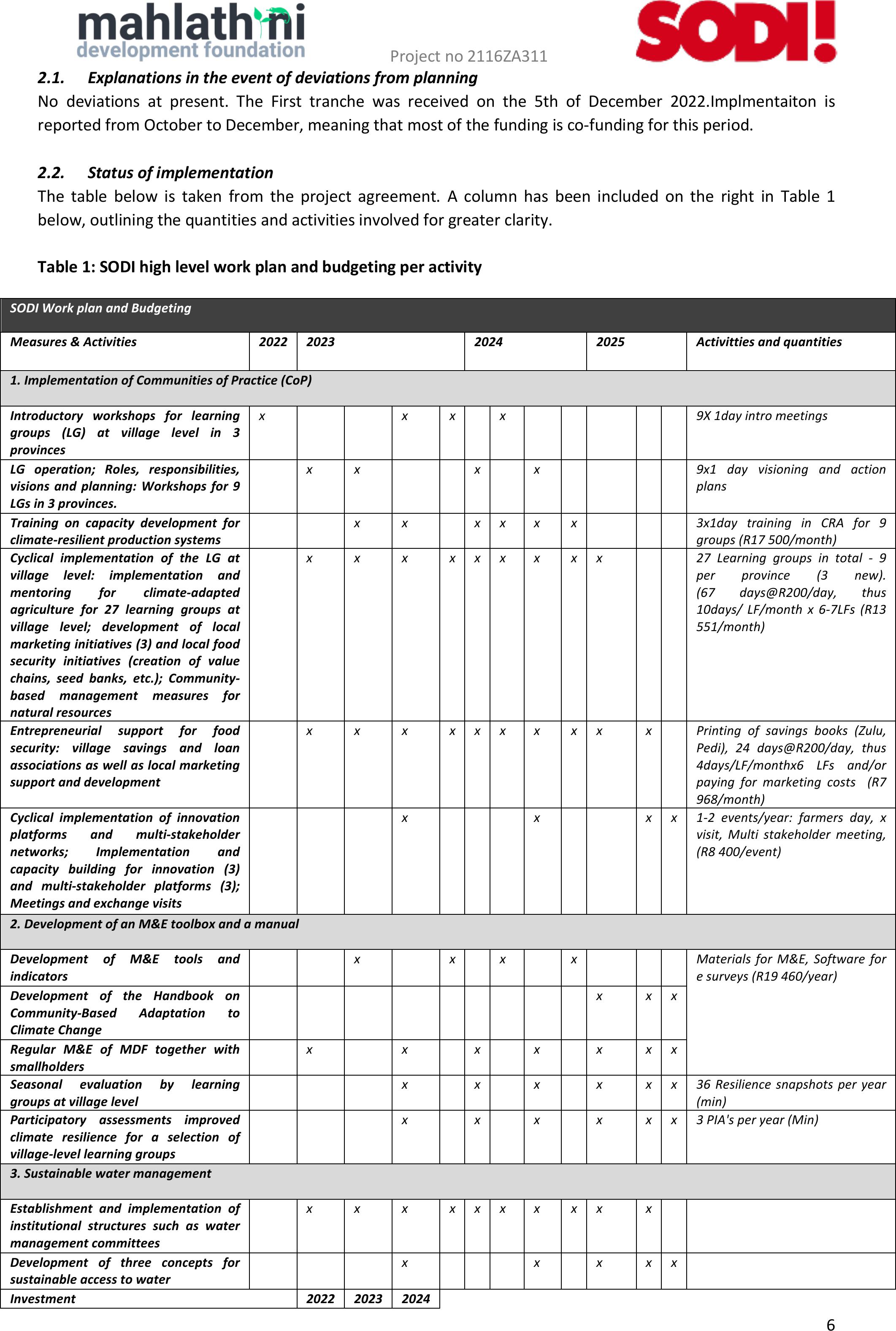
Project no 2116ZA311
6
2.1.Explanations in the event ofdeviations from planning
No deviations at present.The First tranche was receivedon the 5thof December2022.Implmentaiton is
reported fromOctober to December, meaning that most of the funding is co-funding for thisperiod.
2.2.Status of implementation
Thetable below is takenfrom the project agreement. A column has been included on the right inTable 1
below, outlining the quantitiesandactivities involvedfor greater clarity.
Table 1: SODI high level work plan and budgeting per activity
SODI Work plan and Budgeting
Measures & Activities
2022
2023
2024
2025
Activitties and quantities
1. Implementation of Communities of Practice (CoP)
Introductory workshops for learning
groups (LG) at village level in 3
provinces
x
x
x
x
9X 1day intromeetings
LG operation; Roles, responsibilities,
visions and planning: Workshops for 9
LGs in 3 provinces.
x
x
x
x
9x1 day visioning and action
plans
Training on capacity development for
climate-resilient production systems
x
x
x
x
x
x
3x1day training in CRA for 9
groups (R17 500/month)
Cyclical implementation of the LG at
village level: implementation and
mentoring for climate-adapted
agriculture for 27 learning groups at
village level; development of local
marketing initiatives (3) and local food
security initiatives (creation of value
chains, seed banks, etc.); Community-
based management measuresfor
natural resources
x
x
x
x
x
x
x
x
x
27 Learning groups in total - 9
per province (3 new).
(67 days@R200/day, thus
10days/ LF/month x 6-7LFs (R13
551/month)
Entrepreneurial support for food
security: village savings and loan
associations as well as local marketing
support and development
x
x
x
x
x
x
x
x
x
x
Printing of savings books (Zulu,
Pedi), 24 days@R200/day, thus
4days/LF/monthx6 LFs and/or
paying for marketing costs(R7
968/month)
Cyclical implementation of innovation
platforms and multi-stakeholder
networks; Implementation and
capacity building for innovation (3)
and multi-stakeholder platforms (3);
Meetings and exchange visits
x
x
x
x
1-2 events/year: farmers day, x
visit, Multi stakeholder meeting,
(R8400/event)
2. Development of an M&E toolbox and a manual
Development of M&E tools and
indicators
x
x
x
x
Materials for M&E, Software for
e surveys (R19 460/year)
Development of the Handbook on
Community-Based Adaptation to
Climate Change
x
x
x
Regular M&E of MDF together with
smallholders
x
x
x
x
x
x
x
Seasonal evaluation by learning
groups at village level
x
x
x
x
x
x
36 Resilience snapshots per year
(min)
Participatory assessments improved
climate resilience for a selection of
village-level learning groups
x
x
x
x
x
x
3 PIA's per year (Min)
3. Sustainable water management
Establishment and implementation of
institutional structures such as water
management committees
x
x
x
x
x
x
x
x
x
x
Development of three concepts for
sustainable access to water
x
x
x
x
x
Investment
2022
2023
2024
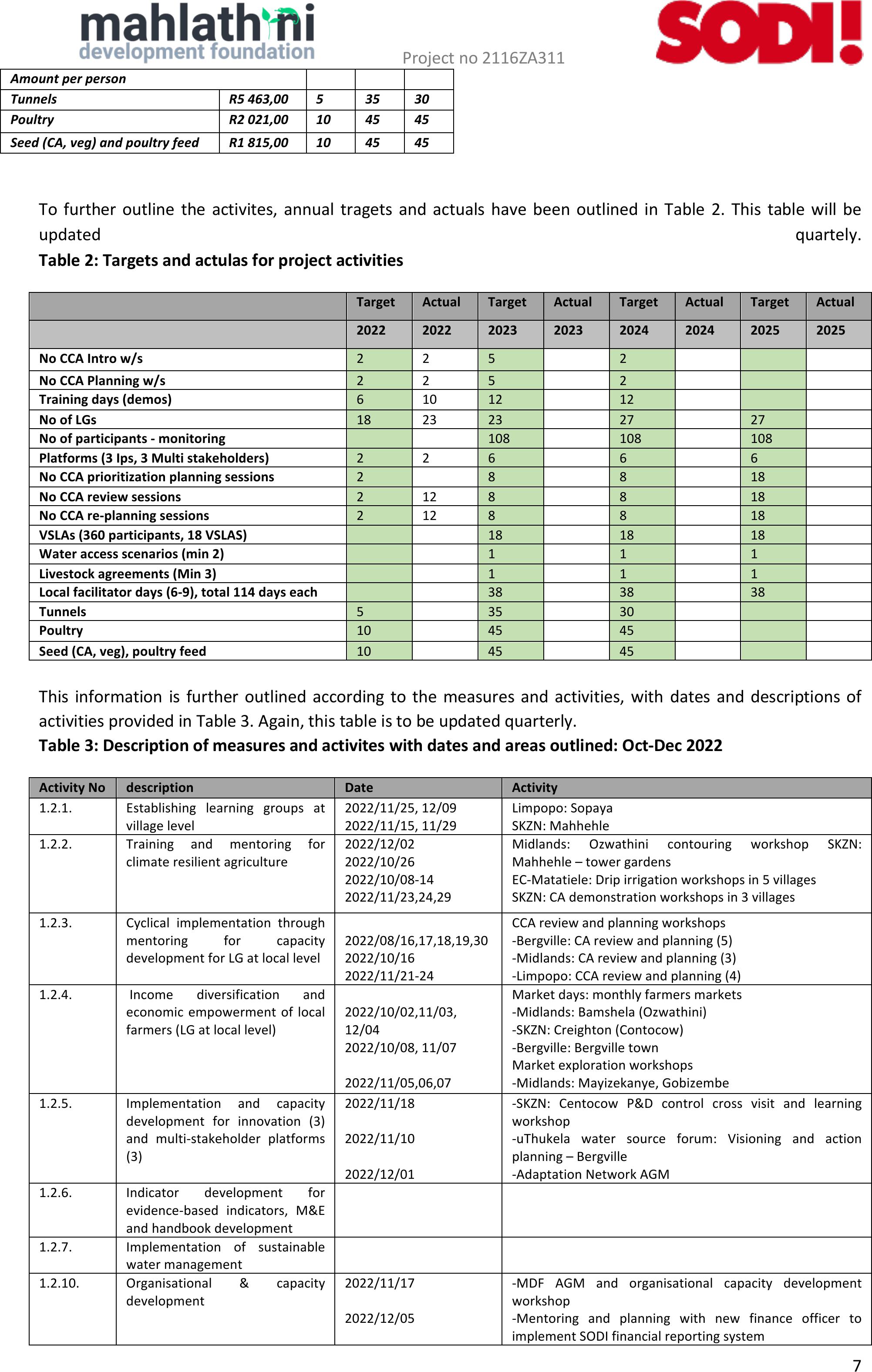
Project no 2116ZA311
7
Amount per person
Tunnels
R5 463,00
5
35
30
Poultry
R2 021,00
10
45
45
Seed (CA,veg) and poultry feed
R1 815,00
10
45
45
To further outline the activites, annualtragets and actuals have beenoutlined in Table 2. This table will be
updated quartely.
Table 2: Targets and actulas for project activities
Target
Actual
Target
Actual
Target
Actual
Target
Actual
2022
2022
2023
2023
2024
2024
2025
2025
No CCA Intro w/s
2
2
5
2
No CCA Planning w/s
2
2
5
2
Training days (demos)
6
10
12
12
No of LGs
18
23
23
27
27
No of participants - monitoring
108
108
108
Platforms (3 Ips, 3 Multistakeholders)
2
2
6
6
6
No CCA prioritization planningsessions
2
8
8
18
No CCA review sessions
2
12
8
8
18
No CCA re-planning sessions
2
12
8
8
18
VSLAs(360 participants, 18 VSLAS)
18
18
18
Water accessscenarios (min 2)
1
1
1
Livestock agreements (Min 3)
1
1
1
Local facilitator days (6-9), total 114 days each
38
38
38
Tunnels
5
35
30
Poultry
10
45
45
Seed (CA, veg), poultry feed
10
45
45
This information is further outlined according to the measures andactivities, with dates and descriptionsof
activities providedin Table 3.Again, this table is to be updated quarterly.
Table 3: Description of measures and activites with dates and areas outlined: Oct-Dec 2022
Activity No
description
Date
Activity
1.2.1.
Establishing learning groups at
village level
2022/11/25, 12/09
2022/11/15, 11/29
Limpopo: Sopaya
SKZN: Mahhehle
1.2.2.
Training and mentoring for
climate resilient agriculture
2022/12/02
2022/10/26
2022/10/08-14
2022/11/23,24,29
Midlands:Ozwathini contouringworkshopSKZN:
Mahhehle – tower gardens
EC-Matatiele: Drip irrigation workshops in 5 villages
SKZN: CA demonstrationworkshops in 3 villages
1.2.3.
Cyclical implementation through
mentoring for capacity
development for LGat local level
2022/08/16,17,18,19,30
2022/10/16
2022/11/21-24
CCA reviewand planningworkshops
-Bergville: CA review and planning(5)
-Midlands: CA review andplanning(3)
-Limpopo: CCA review andplanning (4)
1.2.4.
Income diversification and
economic empowerment of local
farmers (LG at local level)
2022/10/02,11/03,
12/04
2022/10/08, 11/07
2022/11/05,06,07
Market days: monthly farmers markets
-Midlands: Bamshela(Ozwathini)
-SKZN: Creighton(Contocow)
-Bergville: Bergville town
Market exploration workshops
-Midlands: Mayizekanye, Gobizembe
1.2.5.
Implementation and capacity
development for innovation (3)
and multi-stakeholder platforms
(3)
2022/11/18
2022/11/10
2022/12/01
-SKZN:CentocowP&D control cross visit and learning
workshop
-uThukela water source forum: Visioning andaction
planning – Bergville
-Adaptation Network AGM
1.2.6.
Indicator development for
evidence-based indicators, M&E
and handbook development
1.2.7.
Implementation of sustainable
water management
1.2.10.
Organisational& capacity
development
2022/11/17
2022/12/05
-MDF AGM and organisationalcapacity development
workshop
-Mentoring and planning with new finance officer to
implementSODI financial reporting system
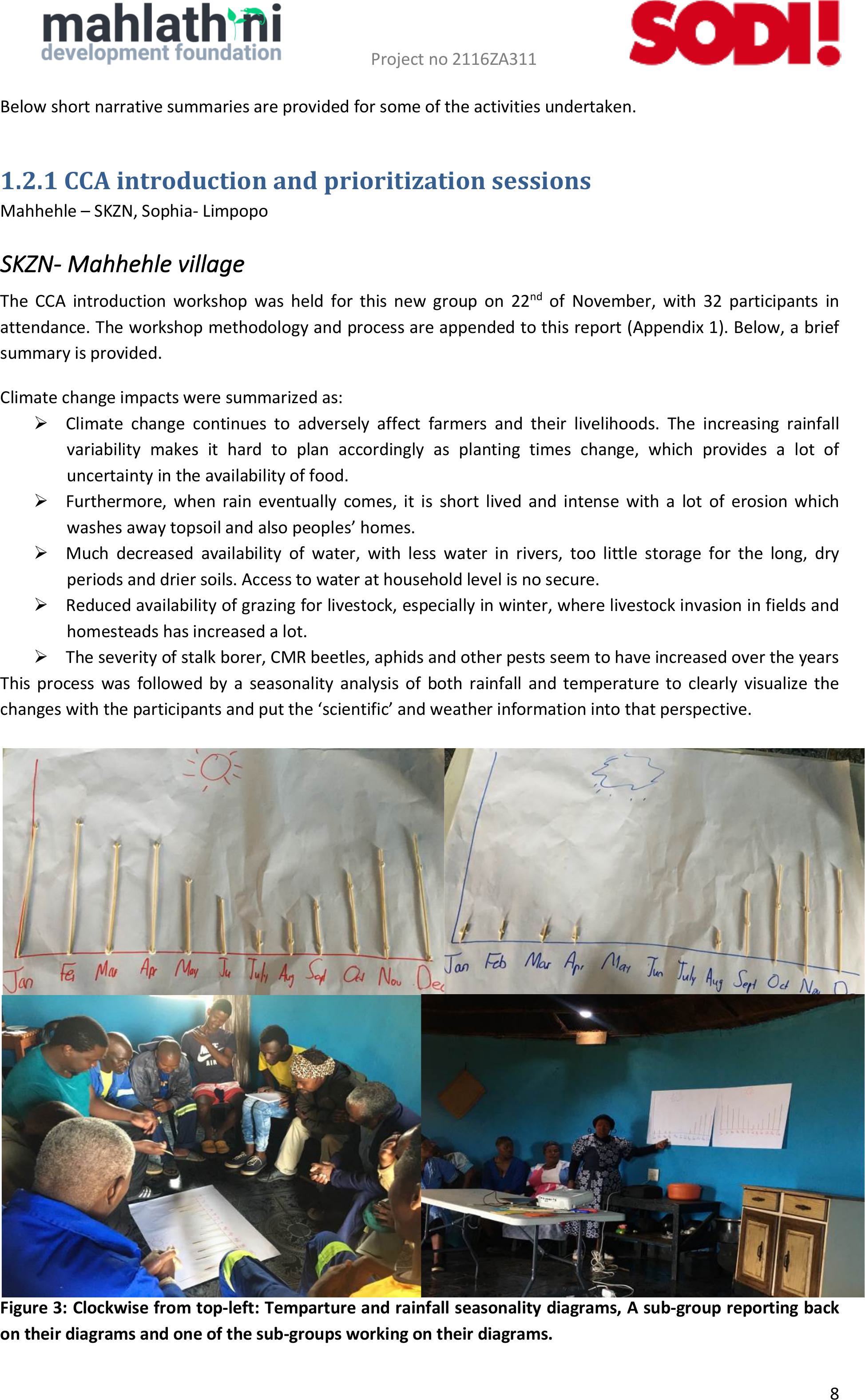
Project no 2116ZA311
8
Below short narrative summariesare provided for some of the activitiesundertaken.
1.2.1$CCA$introduction$and$prioritization$sessions$
Mahhehle – SKZN, Sophia- Limpopo
SKZN- Mahhehle village
The CCA introductionworkshop was held for this new group on 22ndofNovember, with 32 participantsin
attendance. The workshop methodology andprocess areappended to this report(Appendix 1). Below, a brief
summary is provided.
Climatechange impacts were summarized as:
ØClimate change continues to adversely affect farmers and their livelihoods. The increasing rainfall
variability makes it hard to plan accordingly as planting times change, whichprovidesa lot of
uncertainty in the availability of food.
ØFurthermore, when rain eventually comes, it is short lived and intensewith a lotoferosion which
washes away topsoiland also peoples’ homes.
ØMuch decreased availability of water, with less water in rivers, too little storage for thelong, dry
periods and drier soils. Access to water at household level is no secure.
ØReduced availability of grazing for livestock, especiallyin winter, where livestock invasion in fields and
homesteads has increased a lot.
ØThe severity of stalk borer, CMR beetles, aphids and other pests seem to have increased over the years
This process was followed by aseasonalityanalysisof both rainfalland temperature to clearly visualize the
changes with theparticipants andput the ‘scientific’ and weather informationinto that perspective.
Figure 3: Clockwise from top-left: Temparture and rainfallseasonality diagrams, A sub-group reporting back
on their diagrams and one of thesub-groups working on their diagrams.

Project no 2116ZA311
9
There was clear alignmentin these groupsregarding the later onset ofrain, greater variability, more droughts
and floods andoverall increase in temperature in both winter and summer.
The day progressed into a session where thebasket of CCA practices was introduced. These were introduced as
proposed responses to challenges participants are facing, they are practices that will be implementedfor the
purposes of learning new ways of doing things for the positive changes we want to see.The practices broadly
prioritized the followingCCA practices:
ØMicro tunnels, tower gardens, diversion ditches, furrowsand ridges, rainwater harvesting, keyhole
beds, ConservationAgriculture(CA), check dams, natural pest anddisease control and fruit production
In the short-termCAis themost urgent and a date was set for introductionto and demonstrationof practices
within CA forthe 15 participants interested in this practice(29thNovember).
Limpopo- Sekororo-Sophaya village
The CCA workshop was finally held on the 8thof December, after theinitialintroduction into the community,
which was undertaken by Betty Maimela andthe Local facilitatorfor the turkey village Mr Isaac Malatji. Initial
presentations were made to the traditional authority and themunicipal councillorfor the area. After an initial
false start due to internal politicswithin the TA and council, a successfulmeeting with 31 participants (including
12 youths was held).
For this groupthe analysisof past, present and future farmingpractices revealed some interesting trends and
also a very solid understandingfrom participants regardingthe impact of climate change on theirfarming
Past
Present
Future
They used to plant crops like millet,
sorghum and maize and fill more than 100
x 80kg bags
Now they plant maizeonlyand they can
only fill 3 x 50 kg bags
If the weather doesn’t ‘normalize again,
theywill not beable to continue farming
Then they used donkeys and cows for
tractionand they used to help each other
with farming tools
Today they hire tractors for farming,and
they pay for hiring people who will put
seeds in the soil.
With the decrease in yield,they will stop
farming in big fields, some havealready
stopped because of lack of finances
Farming was done in big fields, because
there was a good rain
They are still farming in big fields and
backyards gardens
In future they will rent out their fields to
farmers who want to continue to farm and
focus onbackyard gardens.
They used to have good yield and had
fewer pestproblem
They arefacing a decrease in yield and
have pests and disease problems in both
their gardens and fields
They will start buying pesticides and they
are expensive.
Cultivationof traditional crops was
common:sweetpotatoes, Bambaranuts,
cowpeas, millet, sorghum, pumpkins,
melons,and Maraka
Theystill attempt to cultivatetraditional
crops, but crop failures are leading to a
loss of seed stock
They are not sure they will still have their
indigenous seeds to continue cultivating
The seaosnailty diagrams clearly indicated the significantly
increased temperatures and reduced rain in this region.
Figure 4: Right: Seaonsaility diagram for temperature in Sophaya.
This indicates increased themperatures for every month ofthe
year, with summer temperatures being significantly higher htan in
the past.
In the matrix analysisfor prioritization of climateresilientpractices
to implement, participants focusedontechniquesthat improve soil
andwater conservationand do not require high levels of external
inputs andfinances. The table belowindicates rainwaterharvesting,
use of grey water, banana basins, mixed cropping, crop rotation,
mulching, liquid manures, compost andeco-circles as the favouredpractices to learn aboutand implement.’
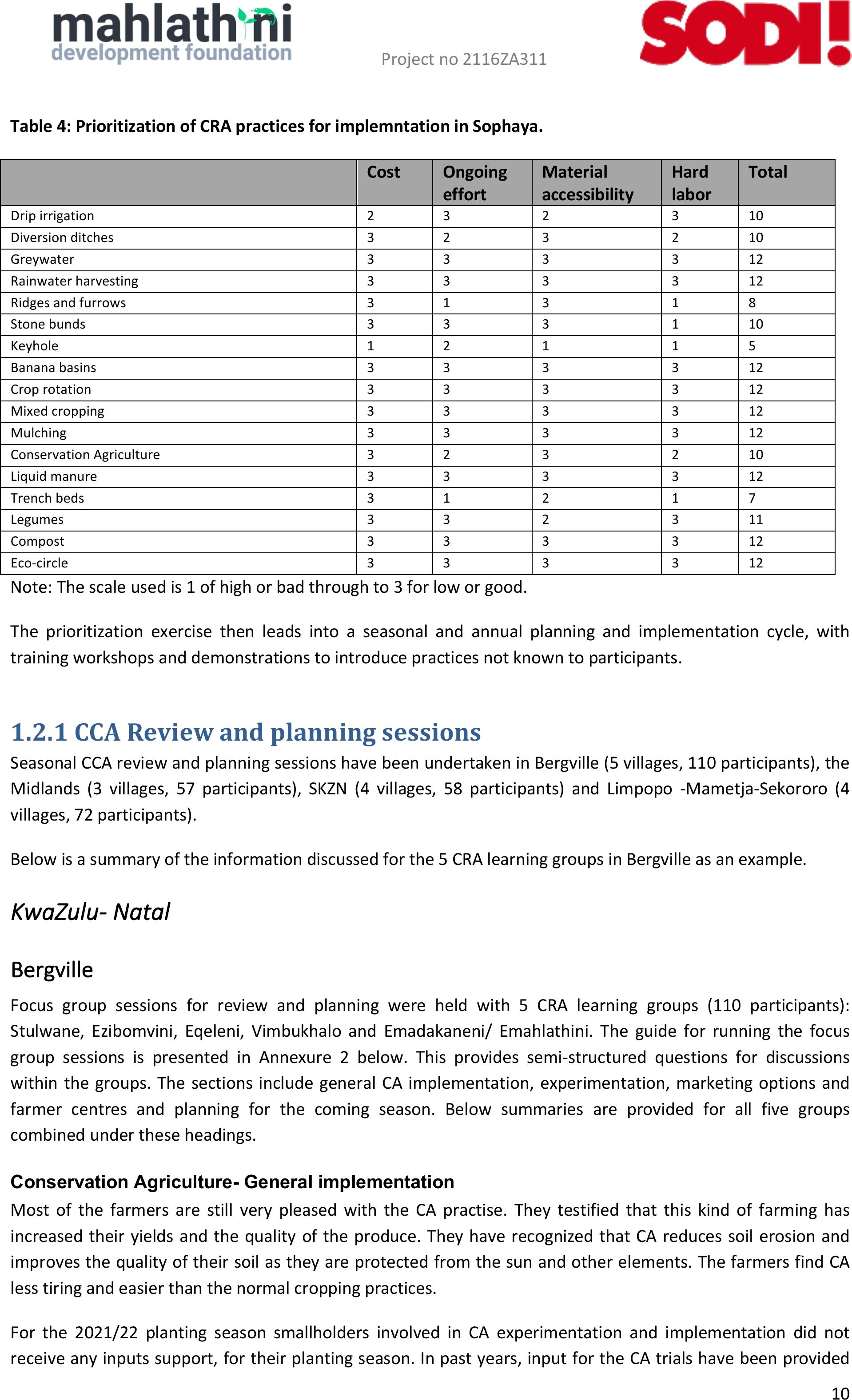
Project no 2116ZA311
10
Table 4: Prioritization of CRA practices for implemntation in Sophaya.
Cost
Ongoing
effort
Material
accessibility
Hard
labor
Total
Drip irrigation
2
3
2
3
10
Diversion ditches
3
2
3
2
10
Greywater
3
3
3
3
12
Rainwater harvesting
3
3
3
3
12
Ridges and furrows
3
1
3
1
8
Stone bunds
3
3
3
1
10
Keyhole
1
2
1
1
5
Banana basins
3
3
3
3
12
Crop rotation
3
3
3
3
12
Mixed cropping
3
3
3
3
12
Mulching
3
3
3
3
12
Conservation Agriculture
3
2
3
2
10
Liquid manure
3
3
3
3
12
Trench beds
3
1
2
1
7
Legumes
3
3
2
3
11
Compost
3
3
3
3
12
Eco-circle
3
3
3
3
12
Note: The scale used is 1 of high orbadthrough to 3 for low or good.
The prioritization exercise then leads into a seasonaland annual planning and implementationcycle, with
training workshops and demonstrationsto introducepractices not known to participants.
1.2.1$CCA$Review$and$planning$sessions$
Seasonal CCA review andplanning sessions havebeen undertaken in Bergville (5 villages, 110 participants), the
Midlands(3 villages, 57 participants), SKZN (4 villages, 58 participants) and Limpopo -Mametja-Sekororo (4
villages, 72 participants).
Belowis a summary of the information discussed for the 5 CRA learning groups in Bergville as an example.
KwaZulu- Natal
Bergville
Focus group sessions for review and planning were held with 5 CRA learning groups(110 participants):
Stulwane, Ezibomvini, Eqeleni, Vimbukhalo andEmadakaneni/ Emahlathini. The guide for running the focus
group sessions is presented in Annexure 2 below. This provides semi-structured questions for discussions
within the groups. The sections includegeneral CA implementation, experimentation, marketing options and
farmer centres andplanning for the coming season. Below summaries are provided for all five groups
combined under these headings.
Conservation Agriculture- General implementation
Most of the farmersare still very pleasedwith the CA practise. They testified that this kindof farming has
increased their yields and the quality of the produce. They have recognized that CA reduces soil erosion and
improves the quality of their soilas they are protected from the sun and other elements. The farmers findCA
less tiring and easier than the normal cropping practices.
For the 2021/22 planting season smallholders involved in CA experimentation and implementation did not
receive any inputs support, for their planting season. In past years, input for the CA trials have been provided

Project no 2116ZA311
11
initially at cost and later at subsidised rates. This lack of support came at a time when inputs costs suddenly
almost doubled and certain inputs became very difficult to access, after the KZN socialunrest.Farmers all
managed to plant their CA plots, although most “skimped” on herbicides and pesticides
CRA learning groups were very appreciative of assistance arranged through MDF for use of the Okahlamba LM
tractors to pull the two-row no tillplanters and assist farmers in planting both the CA trials and their control
plots. The drivershowever have little experience inmanaging no till planters and caused a lot of damage to the
planters by driving across the fields too fast. In Stulwane the farmers have come together to pay a annual fee
of R100 each for use of the planters as a maintenance fund. This hasworked very well, despite a few of the
farmers reneging on the contributions.
The heavy rainfall towards the end of the season – between January and April 2022 had devastating
consequences in the communities, through washing away of roads, and homes. Some participants’ fields also
had a lot of run off damage – although the CA fields performed well in comparison to their normal fields and
those that were ploughed washed away almost completely.
Most of the farmers practicing CA for more than 4 years managed to realize good yields for maize from their CA
plots despite the heavy rainfall. Bean harvests were almost completely decimated.
Livestock invasions in the unfenced fields was a big problem in almost all the villagesas the agreements to send
cattle to the mountains insummer to allow for cropping have not been adhered to by livestock owners- given
the fast deteriorationof veld condition. The latter is dueto overgrazing and four years of heat and below
average rainfall, then followed by exceptionally high rainfall.
Participants feltthat the one maize variety PAN53, an old generic hybrid, coped the best with these new wet
challenging conditions, as the maize cobs mature closed and as a result suffered a lot less form water damage
and rotting. Pan53 however takes a long time to mature and is thus more susceptible to diseases, of which
there was a high incidence in this season. Participants felt that the short season maize(PAN156A)has a
number of distinct benefits, in that it can be planted later and matures fast, despite the cobs being smaller than
for the generic hybrids. They like the idea of planting different types of maize that can accommodate a range
of different conditions, as it is impossible to know exactly what will happen in a season.
There was also the recognition that soils are slowly acidifying again after lime application3-4 years ago and
participants asked for assistance in procurement of lime – mostly transportas they offered to pay for the lime
itself.
Farmers also undertook to discuss their issues with the livestock committees in theirvillages and to impress
upon the livestock farmers that cropping is also an important activity in the area and needs to be respected.
They further suggested that those who are not yetmembers of village savings and loan associations should
join, as these groups assist a lot in having finances available for planting.
Some farmers stressed that the two row planters that are shared in the groups need to be looked after
properly. If a farmer doesn’t clean out the fertilizer after use, corrosion occurs and then the planter doesn’t
work properly when the next participant wants to use it. They then need to spend time on cleaning and
maintaining the planter before using it.MrOmegaKubone, the KZNDARD extension officer joined in four of
these planning sessions (Stulwane, Vimbukhalo, Eqeleni and Ezibomvini as these groups are also setting up
cooperatives under the auspices of the Department to be able to benefit from support being offered.
Markets and farmer centres
The farmer centre in Ezibomvini is still very popular and well used buthas not been tried out effectively in the
other villages. The localmarketing stalls set up first at the pension pay out points and later in Bergville town
itself has worked very well. Farmers make a little income every time they join these marketsand can sell their
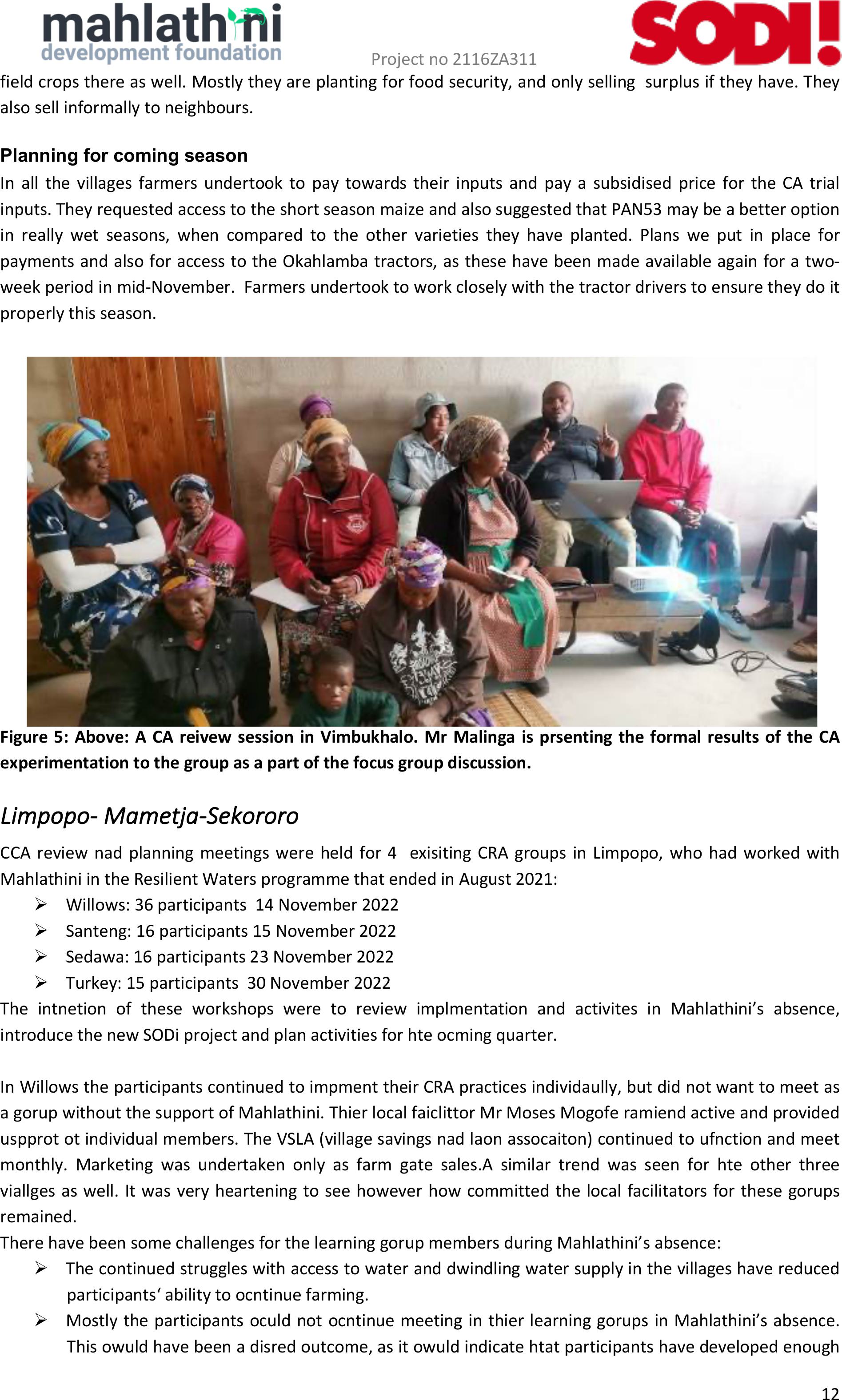
Project no 2116ZA311
12
field crops there as well. Mostly they are planting for food security, and only selling surplus if they have. They
alsosell informally to neighbours.
Planning for coming season
In all the villages farmers undertook to pay towards their inputs and pay a subsidised price for theCA trial
inputs. They requested access to the short season maize and also suggested that PAN53 may be a better option
in really wet seasons, when compared to the other varieties they have planted. Plans we put in place for
payments and also for access to the Okahlamba tractors, as these havebeen made available again for a two-
week period in mid-November. Farmers undertook to work closely with the tractor driversto ensure they do it
properly this season.
Figure 5: Above: A CA reivewsession inVimbukhalo. Mr Malinga is prsenting the formal results of the CA
experimentationto the group as a part of the focus group discussion.
Limpopo- Mametja-Sekororo
CCA review nad planning meetings were held for 4 exisiting CRA groups in Limpopo, who had worked with
Mahlathini in the Resilient Waters programme that ended in August 2021:
ØWillows: 36 participants 14 November 2022
ØSanteng: 16 participants 15 November 2022
ØSedawa: 16 participants 23 November 2022
ØTurkey: 15 participants 30 November 2022
The intnetion of these workshops were to review implmentationand activites in Mahlathini’s absence,
introduce the new SODi project and plan activities for hte ocming quarter.
In Willows the participants continued to impment their CRA practices individaully, but did not want to meet as
a gorup without the support of Mahlathini. Thier local faiclittor Mr Moses Mogofe ramiend active and provided
uspprot ot individual members. The VSLA (village savings nad laon assocaiton) continued to ufnction and meet
monthly.Marketing was undertaken only asfarm gate sales.A similar trend was seen for hte other three
viallges as well. It was very heartening to see however how committed the local facilitators for these gorups
remained.
There have been some challenges for the learning gorup members during Mahlathini’s absence:
ØThe continued struggles with access to water and dwindlingwatersupply in the villages have reduced
participants‘ ability to ocntinue farming.
ØMostly the participants oculd notocntinue meeting in thier learninggorups inMahlathini’s absence.
This owuld have been a disred outcome, as itowuld indicate htat participants have developed enough
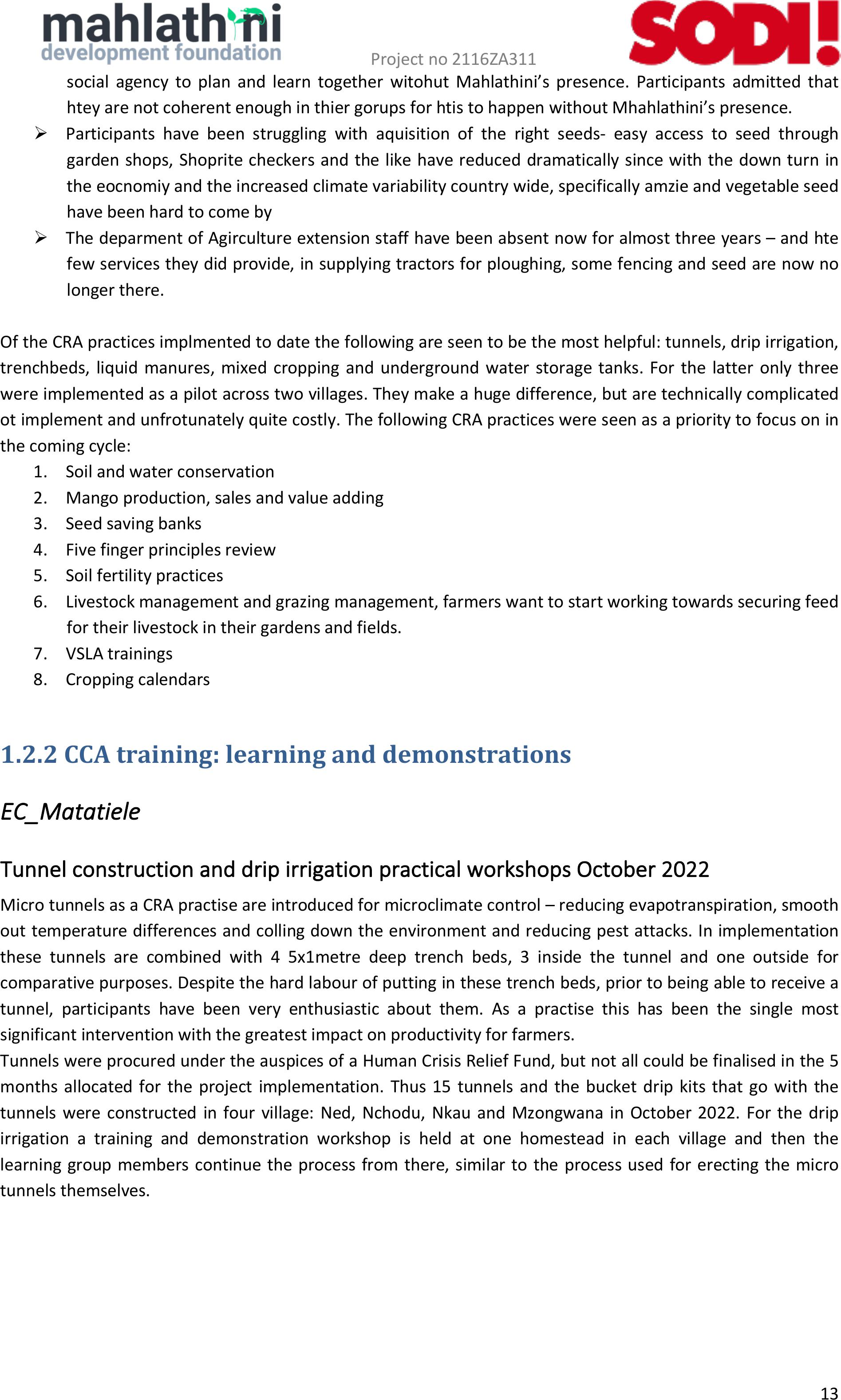
Project no 2116ZA311
13
social agency to plan and learn together witohut Mahlathini’s presence. Participants admitted that
htey are not coherent enough in thier gorups for htis to happen without Mhahlathini’s presence.
ØParticipants have been struggling with aquisition of the right seeds- easy access to seed through
garden shops, Shoprite checkers and the like have reduced dramatically since with the down turn in
the eocnomiy and the increased climate variability country wide, specifically amzie and vegetable seed
have been hard to comeby
ØThe deparment of Agirculture extension staff have been absent now for almost three years – and hte
few services they did provide, in supplying tractors for ploughing, some fencing and seed are now no
longer there.
Of the CRA practices implmented to date the following are seen to be the most helpful: tunnels, drip irrigation,
trenchbeds, liquid manures, mixed croppingandunderground water storage tanks. For the latter only three
were implemented as a pilot across two villages. They make a huge difference, but are technically complicated
ot implement and unfrotunately quite costly. The following CRA practices wereseen as a priority to focus on in
the coming cycle:
1.Soil and water conservation
2.Mango production, salesand value adding
3.Seed saving banks
4.Five finger principles review
5.Soil fertility practices
6.Livestock management and grazing management, farmers want to start working towards securing feed
for their livestock in their gardens and fields.
7.VSLA trainings
8.Croppingcalendars
1.2.2$CCA$training:$learning$and$demonstrations$
EC_Matatiele
Tunnel constructionand drip irrigation practical workshopsOctober2022
Micro tunnels as a CRA practiseare introducedfor microclimatecontrol – reducingevapotranspiration, smooth
out temperature differences andcolling down the environmentand reducing pest attacks.In implementation
these tunnels are combinedwith 4 5x1metre deep trench beds, 3 inside the tunnel and one outside for
comparative purposes.Despite thehard labour of putting in these trench beds, priorto being able to receive a
tunnel, participants have been very enthusiastic aboutthem. As a practise this has been the single most
significant interventionwith the greatest impact on productivity for farmers.
Tunnels were procured under theauspicesof a Human Crisis ReliefFund, but not allcould be finalised in the 5
months allocatedfor the projectimplementation. Thus 15 tunnels andthe bucket drip kits that go with the
tunnels were constructed in four village: Ned, Nchodu, Nkau and Mzongwana in October 2022.For the drip
irrigation a trainingand demonstrationworkshop is held at one homestead in each villageand then the
learning group members continuethe process from there, similar totheprocess used for erecting the micro
tunnelsthemselves.
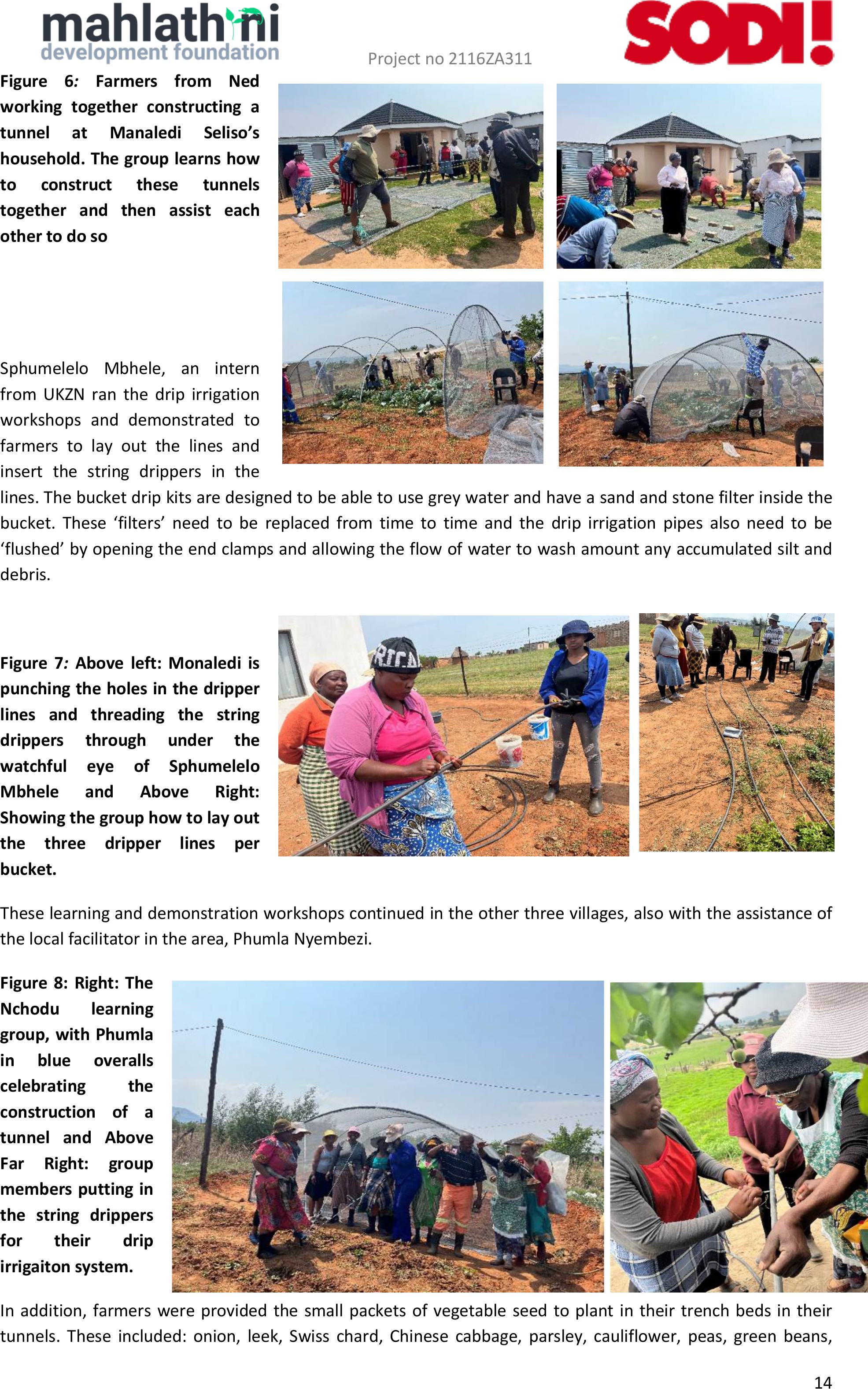
Project no 2116ZA311
14
Figure 6: Farmers from Ned
working together constructing a
tunnel at Manaledi Seliso’s
household. The group learns how
to constructthese tunnels
together and then assisteach
other to do so
Sphumelelo Mbhele, an intern
from UKZN ran the drip irrigation
workshops and demonstratedto
farmersto lay out the lines and
insert the string drippers in the
lines. The bucketdrip kits are designed to be able touse grey water and have a sand and stone filter inside the
bucket. These ‘filters’ needto be replaced from time to time and thedrip irrigation pipes also need to be
‘flushed’ by opening the end clamps and allowing the flow of water to wash amount any accumulated silt and
debris.
Figure 7: Above left: Monaledi is
punching the holes in the dripper
lines andthreading the string
drippers through under the
watchful eye of Sphumelelo
Mbhele and AboveRight:
Showing the group how to lay out
the three dripper lines per
bucket.
These learning and demonstrationworkshops continued in the other three villages, also with the assistanceof
the local facilitatorin the area, Phumla Nyembezi.
Figure 8: Right: The
Nchodu learning
group, with Phumla
in blue overalls
celebrating the
construction of a
tunnel and Above
Far Right: group
members putting in
the string drippers
for their drip
irrigaiton system.
In addition, farmers were provided the small packets of vegetable seed to plantintheirtrench beds in their
tunnels. These included: onion, leek, Swiss chard, Chinese cabbage, parsley, cauliflower, peas, green beans,
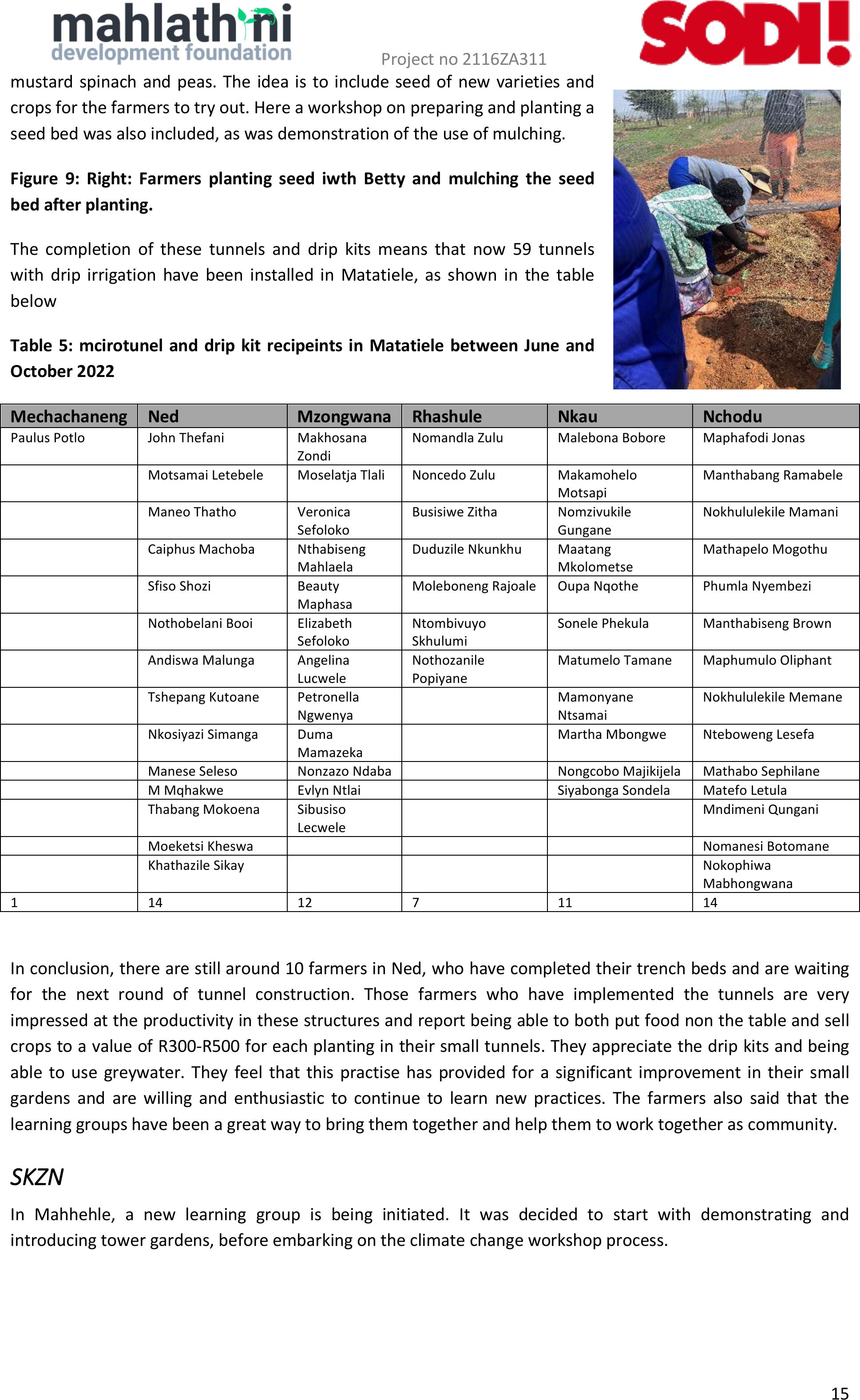
Project no 2116ZA311
15
mustard spinachand peas.The idea is to includeseed of newvarietiesand
crops for the farmers to try out. Here a workshop on preparingandplanting a
seed bed was also included, as was demonstrationof the use of mulching.
Figure 9: Right: Farmers planting seed iwth Betty and mulching the seed
bed after planting.
The completionof these tunnelsanddrip kitsmeans that now 59 tunnels
with drip irrigationhave been installed inMatatiele, as shown in the table
below
Table 5: mcirotunel and drip kit recipeints in Matatiele between June and
October 2022
Mechachaneng
Ned
Mzongwana
Rhashule
Nkau
Nchodu
Paulus Potlo
John Thefani
Makhosana
Zondi
NomandlaZulu
MalebonaBobore
Maphafodi Jonas
Motsamai Letebele
Moselatja Tlali
Noncedo Zulu
Makamohelo
Motsapi
Manthabang Ramabele
Maneo Thatho
Veronica
Sefoloko
Busisiwe Zitha
Nomzivukile
Gungane
Nokhululekile Mamani
Caiphus Machoba
Nthabiseng
Mahlaela
DuduzileNkunkhu
Maatang
Mkolometse
Mathapelo Mogothu
Sfiso Shozi
Beauty
Maphasa
Moleboneng Rajoale
Oupa Nqothe
Phumla Nyembezi
Nothobelani Booi
Elizabeth
Sefoloko
Ntombivuyo
Skhulumi
Sonele Phekula
Manthabiseng Brown
Andiswa Malunga
Angelina
Lucwele
Nothozanile
Popiyane
Matumelo Tamane
Maphumulo Oliphant
Tshepang Kutoane
Petronella
Ngwenya
Mamonyane
Ntsamai
Nokhululekile Memane
Nkosiyazi Simanga
Duma
Mamazeka
Martha Mbongwe
Nteboweng Lesefa
Manese Seleso
Nonzazo Ndaba
Nongcobo Majikijela
Mathabo Sephilane
M Mqhakwe
Evlyn Ntlai
Siyabonga Sondela
Matefo Letula
Thabang Mokoena
Sibusiso
Lecwele
Mndimeni Qungani
Moeketsi Kheswa
Nomanesi Botomane
Khathazile Sikay
Nokophiwa
Mabhongwana
1
14
12
7
11
14
In conclusion, there are still around 10 farmers in Ned,who have completedtheirtrenchbeds andare waiting
for thenext roundof tunnel construction. Those farmers who haveimplementedthe tunnels are very
impressed at theproductivityin these structuresandreport being able to both put food non the table and sell
crops to a valueof R300-R500 for each planting in their smalltunnels. They appreciate the drip kits andbeing
able to use greywater. They feel that this practise has provided for a significant improvementin theirsmall
gardensand are willing and enthusiastic to continueto learn new practices. Thefarmers also said that the
learning groups have been a great way to bring them together and help them to work together as community.
SKZN
In Mahhehle, a new learninggroup is being initiated. It was decided to start with demonstratingand
introducing tower gardens, before embarking on the climate change workshop process.
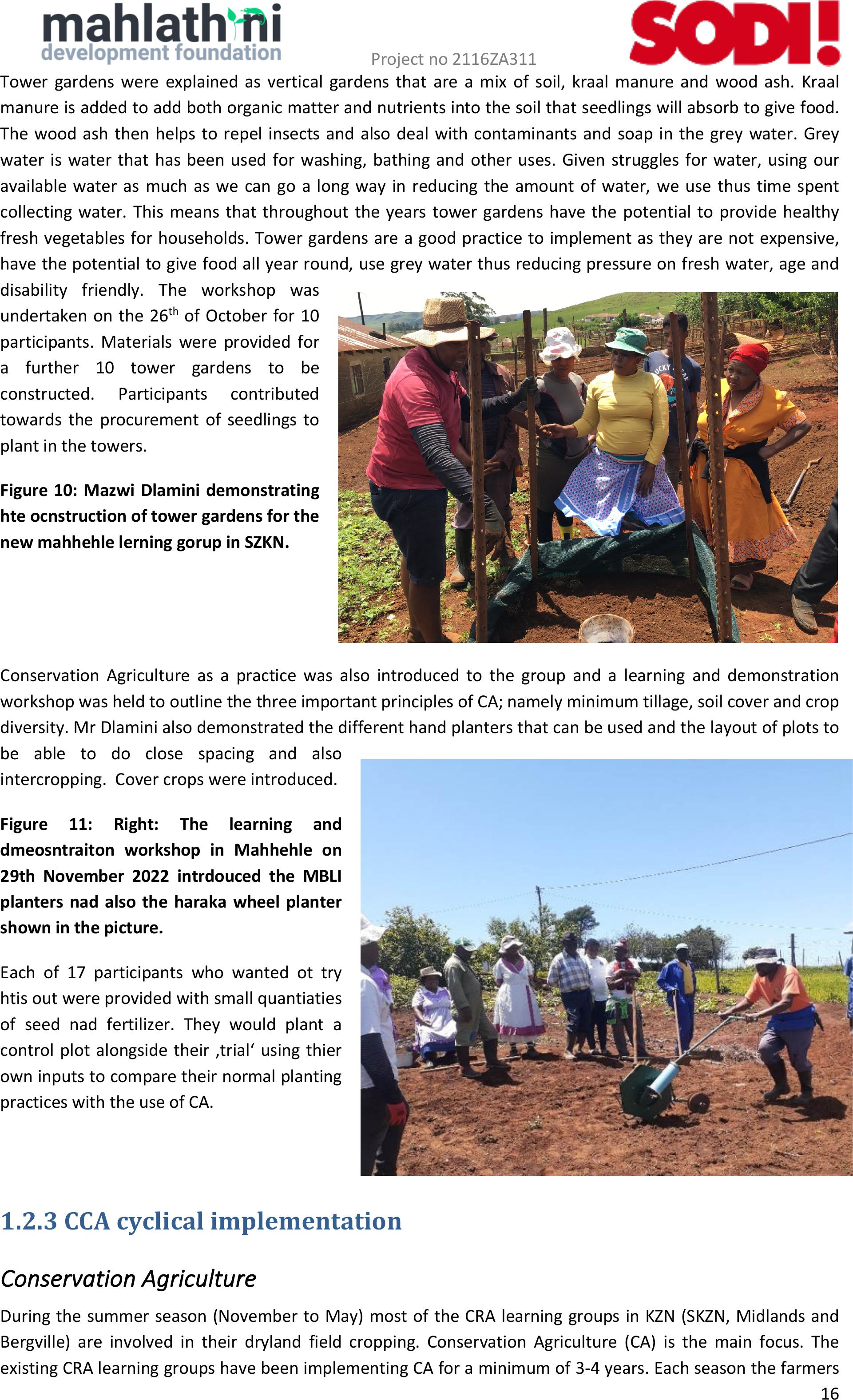
Project no 2116ZA311
16
Tower gardens were explained as vertical gardens that are a mix of soil, kraal manure and wood ash. Kraal
manure is added to add both organic matterandnutrients intothe soil that seedlings will absorb to give food.
The woodash then helps to repel insects and also deal withcontaminants andsoap in the grey water. Grey
water is water that has been used for washing, bathing and other uses. Given struggles for water, using our
available water as much as we can go a long way inreducing the amount of water,we use thus time spent
collecting water. This meansthat throughout the years towergardens have the potentialto provide healthy
fresh vegetables for households.Towergardens are a good practice to implement as they are notexpensive,
have the potential to give food all year round, use grey water thus reducing pressure on fresh water, age and
disability friendly. The workshopwas
undertakenon the 26thof October for10
participants. Materialswere provided for
a further 10 tower gardens to be
constructed. Participantscontributed
towards the procurementof seedlings to
plant in the towers.
Figure 10: Mazwi Dlaminidemonstrating
hte ocnstruction of tower gardens for the
new mahhehle lerning gorup in SZKN.
Conservation Agriculture as a practice wasalso introduced to the group anda learning anddemonstration
workshop was held to outline the three important principles of CA; namely minimum tillage,soil cover and crop
diversity. Mr Dlamini also demonstratedthedifferent hand plantersthat can be used and the layout of plots to
be able to do close spacingand also
intercropping. Cover crops were introduced.
Figure 11: Right: The learning and
dmeosntraiton workshop in Mahhehleon
29th November 2022 intrdouced the MBLI
planters nad also the haraka wheel planter
shown in the picture.
Eachof 17 participants who wanted ot try
htis out were provided with small quantiaties
of seed nad fertilizer. They would plant a
control plot alongside their ‚trial‘ using thier
own inputs to compare their normal planting
practices with the use of CA.
1.2.3$CCA$cyclical$implementation$
ConservationAgriculture
During the summer season(November to May) most oftheCRA learning groups in KZN(SKZN,Midlandsand
Bergville)areinvolved in theirdryland field cropping. ConservationAgriculture(CA)is the mainfocus. The
existing CRA learning groupshave been implementingCA for a minimum of 3-4 years. Each seasonthe farmers
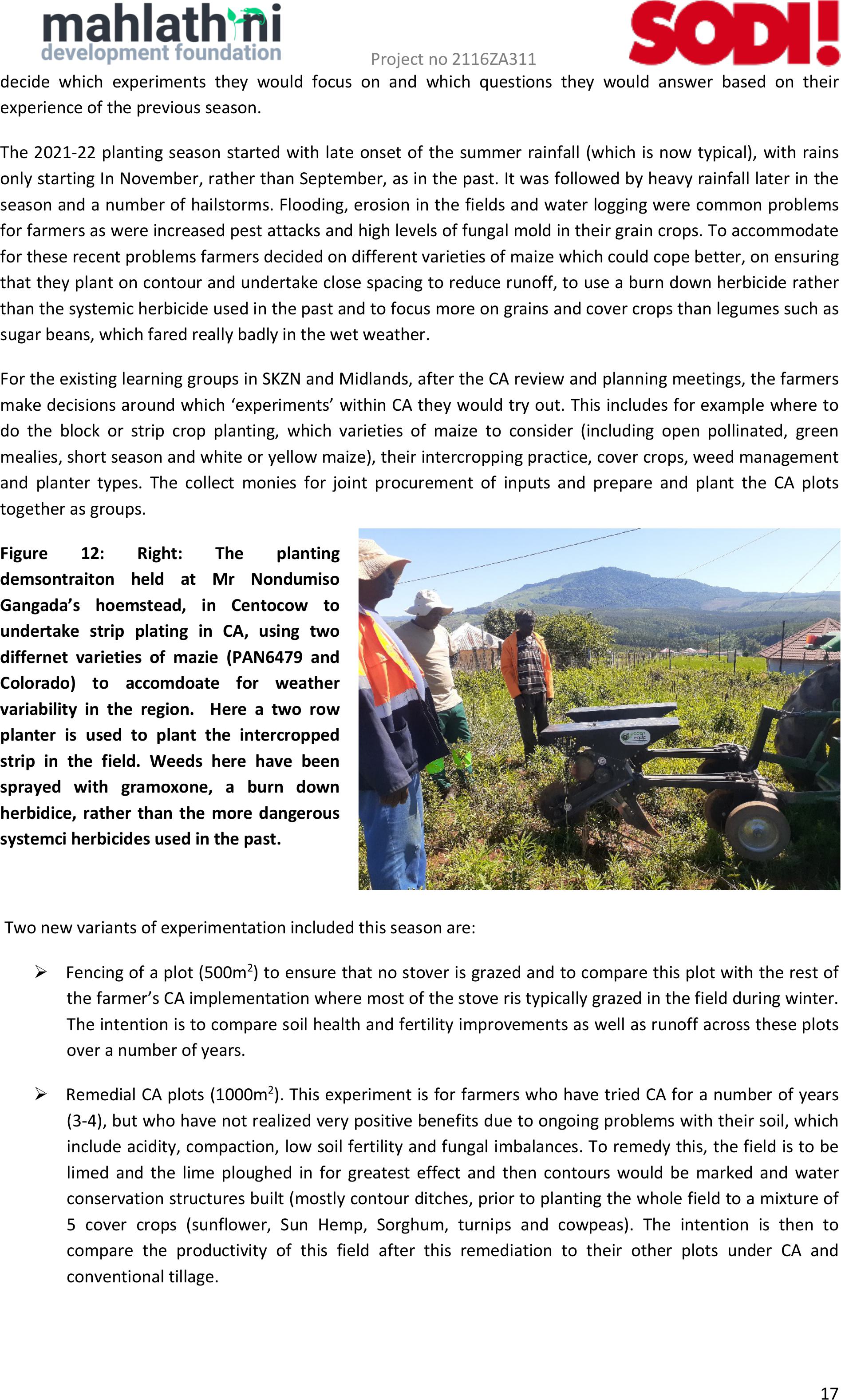
Project no 2116ZA311
17
decide which experimentsthey would focus on and which questions they would answer based on their
experience of the previous season.
The 2021-22 planting season started with late onset of the summer rainfall (which is now typical), with rains
only starting In November, rather than September, as in the past. It was followed by heavy rainfalllater in the
seasonand a number of hailstorms. Flooding, erosion in the fields and water logging were common problems
for farmers as were increased pest attacks and high levels of fungal moldin theirgrain crops. To accommodate
forthese recent problems farmers decided on different varietiesof maize which could cope better, on ensuring
that they planton contour and undertake close spacingto reduce runoff, to use a burn downherbicide rather
than the systemicherbicide used in the pastand to focus more on grains and cover crops than legumessuch as
sugar beans, which fared really badly in the wet weather.
For the existinglearning groups in SKZN and Midlands, after the CA review and planning meetings, the farmers
make decisionsaroundwhich‘experiments’ within CA they would try out.This includes for examplewhere to
do the block or strip crop planting, which varietiesof maizeto consider (including open pollinated, green
mealies, short seasonand white or yellow maize), their intercropping practice, cover crops, weed management
and plantertypes. Thecollect monies for joint procurementof inputsand prepareand plant the CA plots
together as groups.
Figure 12: Right:The planting
demsontraiton held at Mr Nondumiso
Gangada’s hoemstead, in Centocow to
undertake strip plating inCA, using two
differnet varieties of mazie (PAN6479 and
Colorado) to accomdoate for weather
variability in the region. Here a two row
planter is used to plant the intercropped
strip in the field. Weeds here have been
sprayed with gramoxone, a burn down
herbidice, rather than the more dangerous
systemci herbicides used in the past.
Two new variantsof experimentation included thisseasonare:
ØFencing of a plot (500m2) to ensure that no stover is grazed and to compare this plot with the rest of
the farmer’s CA implementation where most of the stoveris typically grazed in the field during winter.
The intention is to compare soilhealthand fertilityimprovementsas well as runoffacross these plots
over a number of years.
ØRemedialCA plots (1000m2). This experimentis for farmers whohave tried CA for a number of years
(3-4), but who have not realizedvery positive benefits due to ongoing problems with theirsoil, which
include acidity, compaction, low soil fertilityand fungal imbalances. To remedy this, the field is to be
limed andthe lime ploughed in for greatesteffect and then contours wouldbe markedand water
conservationstructures built (mostly contour ditches, prior to planting thewholefield to a mixtureof
5 cover crops (sunflower, Sun Hemp, Sorghum, turnipsand cowpeas).The intention is then to
comparetheproductivity of this field after thisremediation to their other plots under CA and
conventional tillage.
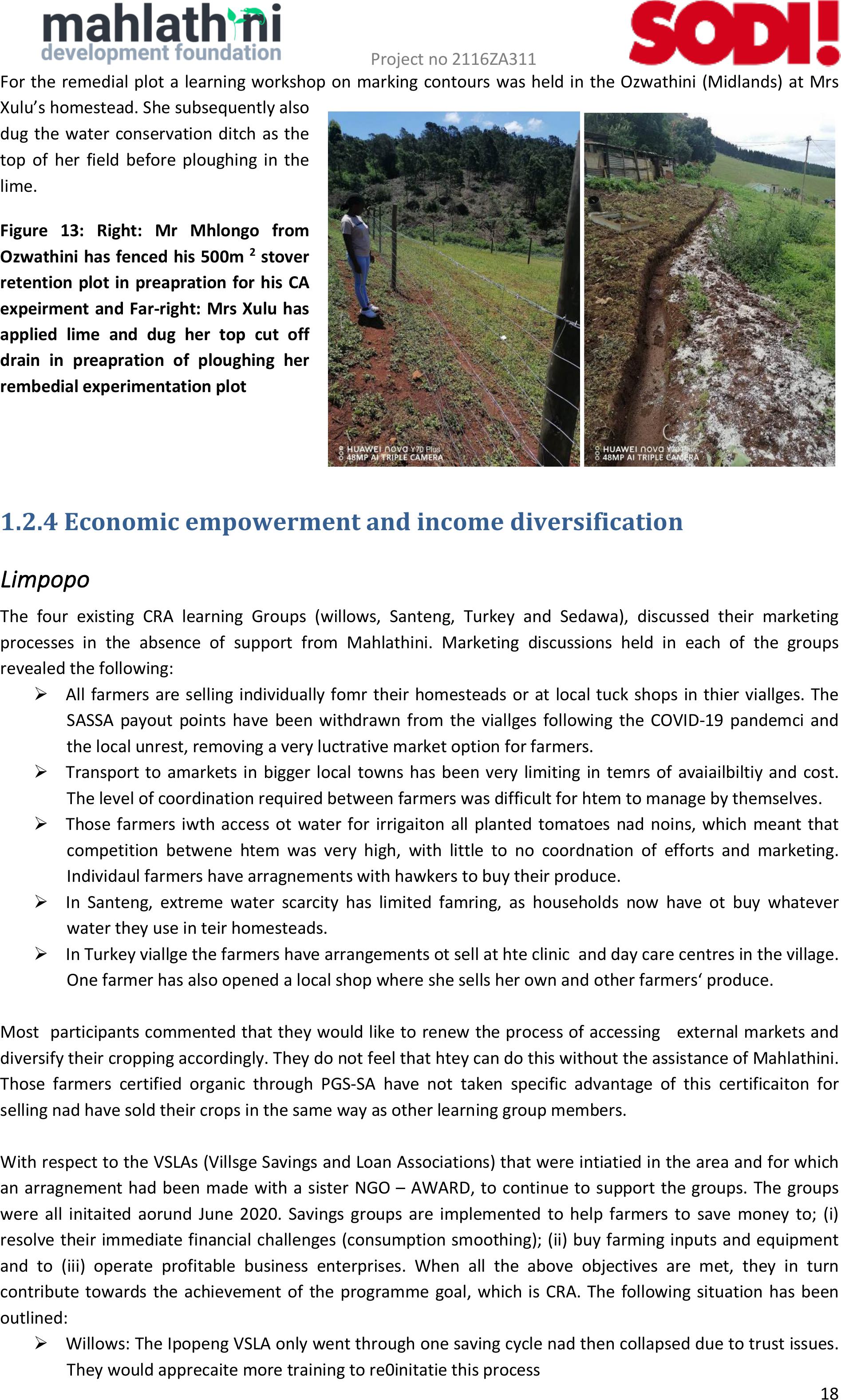
Project no 2116ZA311
18
For theremedial plot a learning workshop on marking contours was held in the Ozwathini (Midlands) at Mrs
Xulu’s homestead.She subsequently also
dug the water conservationditch as the
top of her fieldbefore ploughingin the
lime.
Figure 13: Right:Mr Mhlongo from
Ozwathini has fenced his 500m 2stover
retention plot in preapration for his CA
expeirment and Far-right: Mrs Xulu has
applied lime and dug her top cut off
drain in preapration ofploughing her
rembedial experimentation plot
1.2.4$Economic$empowerment$and$income$diversification$
Limpopo
The four existingCRA learning Groups (willows, Santeng, Turkey and Sedawa), discussed theirmarketing
processes in the absence of support fromMahlathini. Marketing discussions held in each of the groups
revealed the following:
ØAll farmers are sellingindividually fomr their homesteads or at local tuck shops in thier viallges. The
SASSA payout points have been withdrawn from the viallges following the COVID-19 pandemci and
the local unrest, removing a very luctrative market option for farmers.
ØTransport to amarkets in bigger local towns has been very limiting in temrs of avaiailbiltiy and cost.
The level of coordination required between farmers was difficult for htem to manage by themselves.
ØThose farmers iwthaccess ot water for irrigaiton allplanted tomatoes nad noins,which meant that
competition betwene htem was very high, with little to no coordnation of efforts and marketing.
Individaul farmers have arragnements with hawkers to buy their produce.
ØIn Santeng, extreme water scarcity has limited famring, as households now have ot buy whatever
water they use in teir homesteads.
ØIn Turkey viallge the farmers have arrangements ot sell at hte clinic and day care centres in the village.
One farmer has also opened a local shop where she sells her own and other farmers‘ produce.
Most participants commented that they would like to renew the processof accessingexternalmarketsand
diversify their cropping accordingly. They do not feel that htey can do this without the assistance of Mahlathini.
Those farmers certified organic through PGS-SA have not taken specific advantage of this certificaiton for
selling nad have sold their crops in the same way as other learning group members.
With respect to the VSLAs (Villsge Savings and Loan Associations)that were intiatied in the areaand for which
an arragnement had been made with a sisterNGO – AWARD,to continue to support the groups. Thegroups
were all initaited aorund June 2020. Savings groups are implemented to help farmers to save money to; (i)
resolve their immediate financial challenges (consumption smoothing); (ii) buy farming inputs and equipment
and to (iii) operate profitable business enterprises. When all the above objectives are met, they in turn
contribute towards the achievement of the programme goal, which is CRA.The following situation has been
outlined:
ØWillows: The Ipopeng VSLA only went through one saving cycle nad then collapsed due to trust issues.
They would apprecaite more training to re0initatie this process
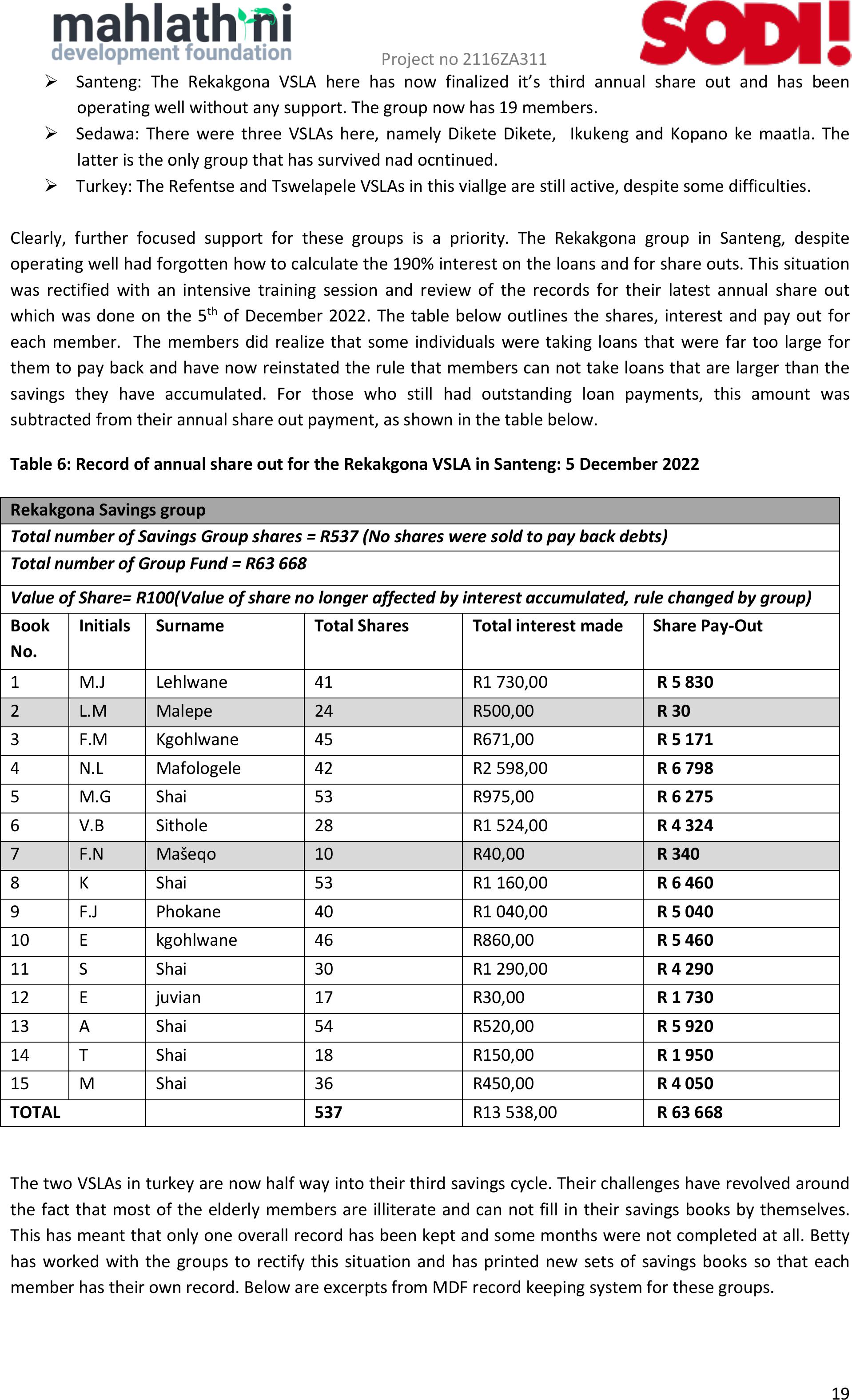
Project no 2116ZA311
19
ØSanteng: TheRekakgonaVSLA here has now finalized it’s third annual share out and has been
operating well without any support. The group now has 19 members.
ØSedawa: There were three VSLAs here, namely Dikete Dikete, Ikukeng and Kopano ke maatla. The
latter is the only group that has survived nad ocntinued.
ØTurkey: The Refentse and Tswelapele VSLAs in this viallge are still active, despite some difficulties.
Clearly, furtherfocused supportfor these groups is a priority. The Rekakgona group in Santeng, despite
operating well had forgotten how to calculatethe190% interest on the loansand forshare outs. This situation
was rectified with an intensive trainingsession and review of the recordsfor their latest annual share out
which was done on the 5thof December 2022. The table below outlines the shares, interest and payout for
each member. The membersdid realize that some individualswere taking loansthat were far too large for
themto pay back and have now reinstated the rule that members cannot take loans that are larger than the
savings they have accumulated.Forthose who still hadoutstandingloanpayments, this amount was
subtracted fromtheirannual share out payment, as shown in the table below.
Table 6: Record of annual share out for theRekakgona VSLA in Santeng:5 December 2022
Rekakgona Savings group
Total number of Savings Group shares = R537(No shares were sold to pay back debts)
Total number ofGroup Fund = R63 668
Value of Share= R100(Valueof share no longer affectedby interest accumulated, rule changed by group)
Book
No.
Initials
Surname
Total Shares
Total interest made
Share Pay-Out
1
M.J
Lehlwane
41
R1 730,00
R 5 830
2
L.M
Malepe
24
R500,00
R 30
3
F.M
Kgohlwane
45
R671,00
R 5 171
4
N.L
Mafologele
42
R2 598,00
R 6 798
5
M.G
Shai
53
R975,00
R 6 275
6
V.B
Sithole
28
R1 524,00
R 4 324
7
F.N
Mašeqo
10
R40,00
R 340
8
K
Shai
53
R1 160,00
R 6 460
9
F.J
Phokane
40
R1 040,00
R 5 040
10
E
kgohlwane
46
R860,00
R 5 460
11
S
Shai
30
R1 290,00
R 4 290
12
E
juvian
17
R30,00
R 1 730
13
A
Shai
54
R520,00
R 5 920
14
T
Shai
18
R150,00
R 1 950
15
M
Shai
36
R450,00
R 4 050
TOTAL
537
R13 538,00
R 63 668
The two VSLAs in turkeyare now half wayinto their third savings cycle.Their challenges have revolvedaround
the fact thatmost ofthe elderlymembers are illiterateand can not fill in their savings books by themselves.
This hasmeant thatonly one overall recordhas been kept and some monthswere notcompleted at all. Betty
has worked with the groupsto rectify thissituation and has printed new sets of savings booksso that each
member hastheir own record. Below are excerpts fromMDF record keeping system for these groups.

Project no 2116ZA311
20
Figure 14: Above Left: the Rekgagaon VSLA doing theirannual share out and Above Right: the Tswelapele
KZN
In two areas,Ozwathini and SKZN (Centocow), monthly farmers marketing stalls have beenundertaken. These
stalls are set up in the nearestlocal town, during the pension payout daysfor these areas. Learning group
members worktogether to provideand collect produce, sell and share out incomes for each individualfarmer.
The stalls are wellbranded and provided with tables andgazebos, which generally attracts a lot more attention
than farmers just setting up on the pavement, as theyhave donein the past.
NAMEOF GROUP:TswelapeleREF NO. OF THE GROUP:MDFSG/0006
Jul Aug Sep Oct Nov Dec Jan Feb Mar Apr May June TOTAL
(A) TOTALSHARES BOUGHT TODAY75 68 65 71 57 74410
(B) TOTALVALUEOF SHARES BOUGHT TODAY7 500R 6 800R 6 500R 7 100R 5 700R 7 400R -R -R -R -R -R -R 41 000,00R
(C) TOTAL LOANS REPAID TODAY03 100R 6 290R 5 168R 7 080R 6 350R 27 988,00R
(D) TOTAL LOANS ISSUED TODAY4 000R 8 600R 2 100R 19 100R 12 000R 12 400R -R -R -R 58 200,00R
(E) MONEY IN THE BOX3 500R 4 815R 15 505R 8 673R 9 536R 10 886R 52 915R
#REF!
CLOSING BALANCES
NAME OF GROUP:Refentse REF NO. OF THE GROUP:MDFSG/0005
jul Aug Sep Oct Nov Dec Jan Feb Mar Apr May Jun TOTAL
(A) TOTAL SHARES BOUGHT TODAY43 55 46 52 34 410 0 0 0 0 0271
(B) TOTALVALUEOF SHARES BOUGHT TODAY4 300R 5 500R 4 600R 5 200R 3 400R 4 100R -R -R -R -R -R -R 27 100,00R
(C) TOTAL LOANS REPAID TODAY02 860R 6 040R 7 188R 9 059R 4 994R 30 141,00R
(D) TOTAL LOANS ISSUED TODAY2 600R 6 200R 8 600R 8 700R 7 900R 10 000R 44 000,00R
(E) MONEY IN THE BOX100R 60R 20R 98R 2 557R -R 2 835R
#REF!
CLOSING BALANCES

Project no 2116ZA311
21
Figure 15: Members of the Ozwathini learning group at hteir monthly market stall in Bamshela. 3 November
2022. This group is well establisehd and has been running thier mrket stall independtly, making thier own
arrangements for transport etc for almost a year. Malhathini still supports in helping with advertising,
packaging, pricing andcoordination.
Figure 16: Right: The very first monthly
makret stallfor hte Centocow learning
gorup in SKZn in the town of
Creighton.
The average incomes fromthese staills
are mostly between R1600-R2800per
day, shared between 2-8 farmers.
1.2.5$Innovation$platforms$and$multi$stakeholder$engagement$
Localitybased cross visits
In SKZN a cross visit between the Mariathal and Centocow learning groupswas undertaken on the 18thof
November. The theme for thevisit was methodsof natural pest anddiseasecontrol as well as value adding and
processing through theproduction of vegetablejuices.
Cross visits are a useful tool in fostering learning among farmers not from the same area. Farmers learn new
ideas on how they could improve their activities through people at the same level as them, making it a lot
easier to interact. A pest and disease cross-visitworkshop was conducted in Southern KwaZulu– Natalcovering
two areas; Centocow and Mariathal; under the Harry Gwala District Municipality. The workshop was heldat
Mr Adrian Williams’ farm in Centocow showing thevarious production activities.

Project no 2116ZA311
22
Figure 17: Mr Williams explaining his process for vegetalbe juice production and paprovinding participants
with samples for tasting.
!The workshop framework was as follows:
•Introduction of farmers and where they come from
•Purpose of the workshop
•Mr Adrian Williams’ introduction tothefarms’productionactivities
•Discussion of pestsand diseases and the various natural pest and disease controls
•Walkabout
oPig production
oTunnel garden
oBroiler chickens
•Eyomdali Vegetable juice process and tasting, lotions and perfumes
•Discussion on Centocow savings group and market day
Mr Williams shared his background in farming and how things have changed since he moved to Centocow. He
explained how he moved to a smaller and manageable farm with the aim that there will be a Centocow Mission
market that he wouldbe able tosupply. Things didnot go as he planned in terms of supply and demand and
would have vegetables going to waste. He thenhad an ideato use his produce that is when he joined
Izenzozomdali co-op and started Eyomdali Enterprise of cold-pressed vegetable juices. Making vegetable juices
was a way of both avoiding waste as well as adding value to his vegetables. He demonstratedhow he makes
and sells these juices.
The discussion on pests anddiseases was a combination of a presentation (power point slides)and discussion
among participants howthey deal with insects and disease problems. Maintaining the natural environment as
much as possible will keep animals including pests, food chains and functions in place to avoid pest and disease
infestationand outbreaks. Whenasked what farmers use to deal with pests, most farmers use ‘blue death’ to
kill insectpestsbut indirectly end up eliminating good insects as wellresulting in disruptions in the system.
Insects such as beesresponsible for pollinationas well aspredators that feed on insect pests such as wasps and
insects that help to decomposeorganic matter are also killed and this reduces life in the garden. A discussion
on dplant diversityandtiming of planting was also held asthese are important considerations, asis fertility
and weed managementGarden sanitationis also important and all these aspectsneed to bemanaged first
before thinking of making pest anddisease controlbrews andmixes. Then a few brews were discussed:
including use of blackjackseeds, chilli, garlic and green bar soap. These are all practices Mr Williams usesashe
is running and organic farm.
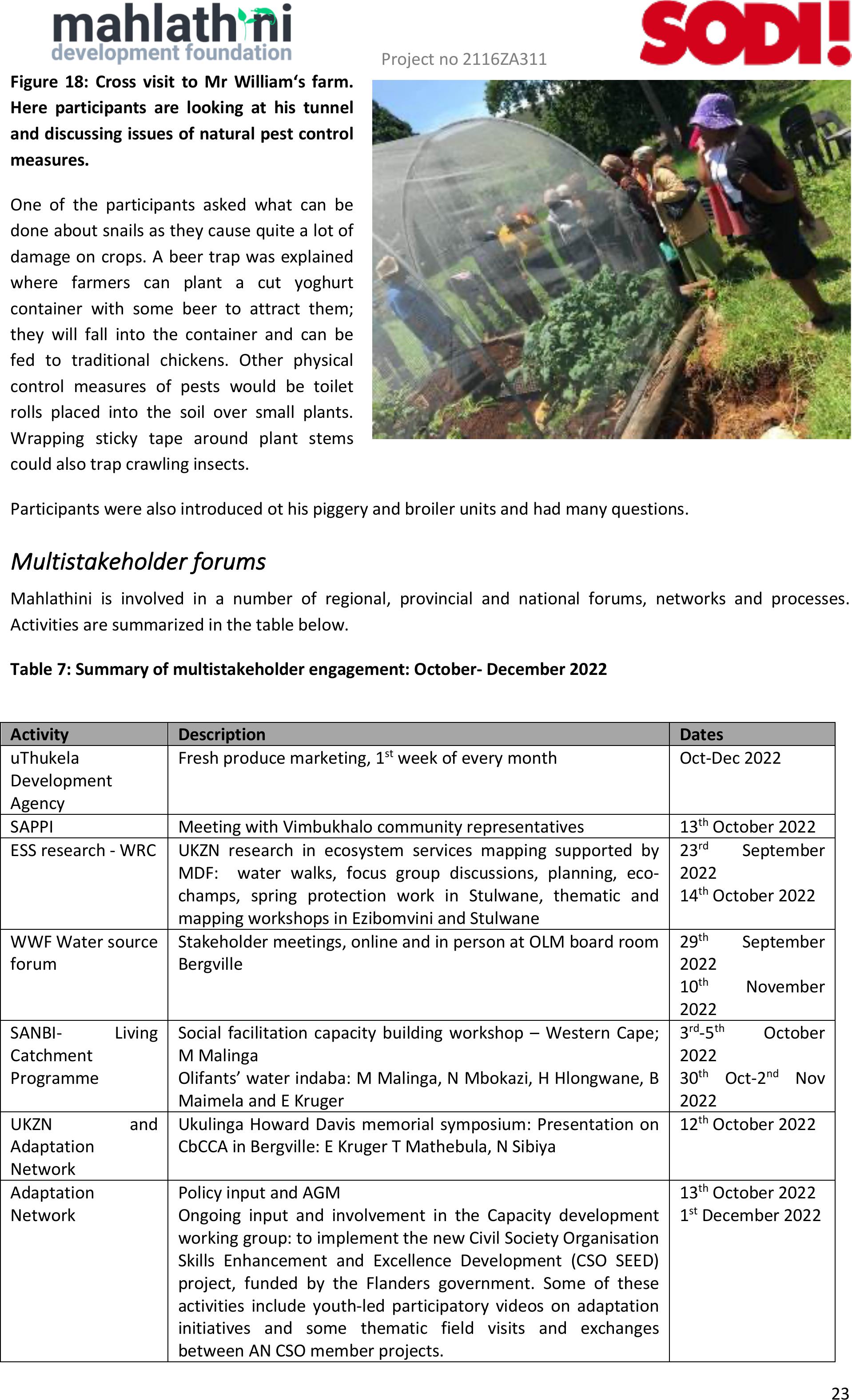
Project no 2116ZA311
23
Figure 18: Cross visit to Mr William‘s farm.
Here participants are looking at his tunnel
and discussing issues of natural pest control
measures.
One of the participants asked what can be
done aboutsnails as they cause quite a lot of
damage on crops. A beer trap was explained
where farmers can planta cut yoghurt
container with some beer to attract them;
they will fall into the container and can be
fed to traditional chickens. Other physical
controlmeasures of pests would be toilet
rolls placedinto the soil oversmall plants.
Wrapping sticky tape aroundplant stems
could also trap crawling insects.
Participants were also introduced othis piggery and broiler units and had many questions.
Multistakeholder forums
Mahlathini is involvedin a number of regional, provincial andnational forums, networksandprocesses.
Activities are summarized in the table below.
Table 7: Summary of multistakeholder engagement: October- December 2022
Activity
Description
Dates
uThukela
Development
Agency
Fresh produce marketing, 1stweek of every month
Oct-Dec 2022
SAPPI
Meeting with Vimbukhalo community representatives
13thOctober 2022
ESS research - WRC
UKZN research in ecosystem services mapping supported by
MDF: water walks, focus group discussions, planning, eco-
champs, spring protection work in Stulwane, thematic and
mapping workshops in Ezibomvini and Stulwane
23rdSeptember
2022
14thOctober 2022
WWF Water source
forum
Stakeholder meetings, online and in person at OLM board room
Bergville
29thSeptember
2022
10thNovember
2022
SANBI- Living
Catchment
Programme
Social facilitationcapacity buildingworkshop – Western Cape;
M Malinga
Olifants’ water indaba: M Malinga,N Mbokazi, H Hlongwane, B
Maimela and E Kruger
3rd-5thOctober
2022
30thOct-2ndNov
2022
UKZN and
Adaptation
Network
Ukulinga Howard Davis memorial symposium: Presentation on
CbCCA in Bergville: EKruger T Mathebula, N Sibiya
12thOctober 2022
Adaptation
Network
Policy input and AGM
Ongoing input and involvementin the Capacity development
working group: to implementthenewCivilSocietyOrganisation
Skills Enhancement and Excellence Development (CSO SEED)
project, fundedby the Flanders government.Some of these
activities include youth-led participatory videos onadaptation
initiativesandsomethematicfieldvisitsandexchanges
between AN CSO member projects.
13thOctober 2022
1stDecember 2022

Project no 2116ZA311
24
Assessment$of$progress$$
The project is on track and no major deviations in the project planning andimplementationis envisaged.
Other$comments$
Date: 12 December2022
PGS-SA
Quarterly meeting: Discuss mapping of PGS organisations,
finalisation ofcertificateanduse of seals andlogos. Finalisation
of smallholderfarm assessment form
17thNovember
2022
Agroecology
network
Online meeting and policy involvementfor reviewing of the
National department of Agriculture’s climatechange
adaptationmaster plan(CCAMP). Letter tothe minister
compiled and endorsed. Led by Mr StephenGreenberg,
arranged by the AfricanCentre for Biodiversity
18thNovember
2022
Okhahlamba LM
Agriculture andLand summit: MDF presentation and marketing
stall: All Bergville staff, farmers representatives andeco champs
30thNovember
2022
Afromontane
research Centre
Maloti-Drakensberg ClimateChangeWorkshop
12-14 December
2022

Project no 2116ZA311
25
Appendix 1: CCA workshop outline
Community level climate change adaptation exploration workshop outline
DAY 1
Time
Activity
Process
Notes
Materials
Who
09:00
INTRODUCTION
09:00-
09:45
Community
and team
introductions
In pairs, take 5 minutes
to talk to each other.
Then introduce each
other to the group.
Choose a person you do
not know well (both
team and community).
Include name and
surname, farming
activities (garden, field,
livestock, natural
resources), income
from farming.
Depending on the
size of the group,
thiscan take a long
time. If time is
short, then just do
a quick round of
introductions.
Attendance register – with
columns for farming
enterprises (so that each
participant can tick what
they do) – in English and
Zulu/Pedi. Name tags,
stickers, kokis.
Materials
and
logistics:
Facilitation:
Recording:
Purpose of the
day
Introduction of the
organisation/s and
purpose of this
workshop – link to
already ongoing
activities if possible and
introduce visitors and
other stakeholders
involved.
Talk about CC
necessitating
adaptation from us
– we may need to
change how we do
things and what we
do – this w/s is to
help us explore
options for such
changes.
Flip-stand, newsprint,
kokis, data projector,
screen, extension cables,
plugs & double adaptors.
Black refusebags and
masking tape (for blacking
out windows), camera, and
one person to undertake to
takephotos throughout
the day. Extra batteries for
camera and sim card.
Materials
and
logistics:
Facilitation:
Recording:
09:50
PRESENT SITUATION
09:50-
10:30
Present
livelihoods and
farming
situation –
discuss impacts
related to CC
Use a series of impact
picturesfrom the local
situation. Include the 5
categories (and describe
them to the group) –
watermanagement
(increased efficiency
and access), soil
management (erosion
control,fertility,
health), crops, livestock
and natural resources.
Impact pictures –
either PowerPoint
or printed on A4 to
facilitate dialogue
(or both).Record
community
comments).
PowerPoint presentation
pictures
PPoint :
Facilitation:
10:30
PAST, PRESENT, FUTURE
10:30-
11:30
Discuss farming
activities as
they have
changed, what
they are now
and what may
happen in the
future if the
present trends
Small groups(5-10
people): facilitated
discussion on farming
activities (include the 5
categories) – prompt for
all five and keep
conversation focussed
OR facilitate a shorter
plenary discussion on
Important to note
and record any
discussions around
changesand
adaptations –
things peopleare
already doing to
accommodate for
changes, and
Small groups: each needs a
facilitator and recorder.
Facilitation:
Recording:
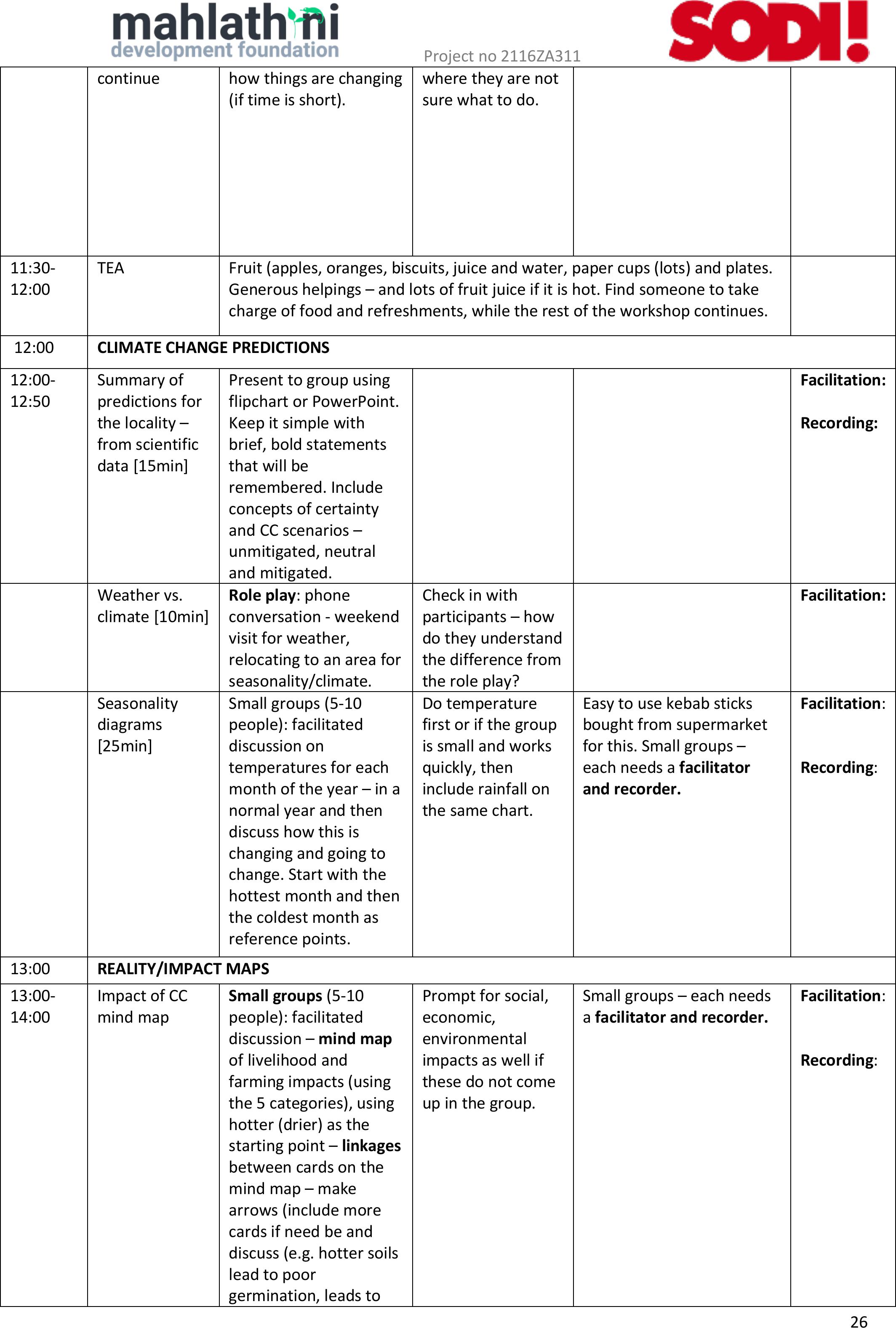
Project no 2116ZA311
26
continue
how things are changing
(if time is short).
where they are not
sure what to do.
11:30-
12:00
TEA
Fruit (apples, oranges, biscuits, juice and water, paper cups (lots) and plates.
Generous helpings – and lots of fruit juice if it is hot. Find someone to take
charge of food and refreshments, while the rest of the workshop continues.
12:00
CLIMATE CHANGE PREDICTIONS
12:00-
12:50
Summaryof
predictions for
the locality –
from scientific
data[15min]
Present to group using
flipchart or PowerPoint.
Keep it simple with
brief, bold statements
that willbe
remembered. Include
concepts of certainty
and CC scenarios –
unmitigated, neutral
and mitigated.
Facilitation:
Recording:
Weather vs.
climate [10min]
Role play: phone
conversation - weekend
visit for weather,
relocating toan area for
seasonality/climate.
Check in with
participants – how
do they understand
the difference from
the role play?
Facilitation:
Seasonality
diagrams
[25min]
Small groups (5-10
people): facilitated
discussion on
temperatures for each
month of the year – in a
normal year and then
discuss how this is
changingand going to
change. Start with the
hottest monthand then
the coldest month as
reference points.
Do temperature
firstor if the group
is small and works
quickly, then
includerainfall on
thesame chart.
Easy to use kebab sticks
bought from supermarket
for this. Small groups –
each needs a facilitator
and recorder.
Facilitation:
Recording:
13:00
REALITY/IMPACT MAPS
13:00-
14:00
Impact of CC
mind map
Small groups(5-10
people): facilitated
discussion – mind map
of livelihood and
farmingimpacts (using
the 5 categories), using
hotter (drier) as the
starting point – linkages
between cards on the
mind map – make
arrows (include more
cards if need be and
discuss (e.g. hotter soils
lead to poor
germination, leads to
Prompt for social,
economic,
environmental
impacts as well if
these do not come
up in thegroup.
Small groups – each needs
a facilitator and recorder.
Facilitation:
Recording:
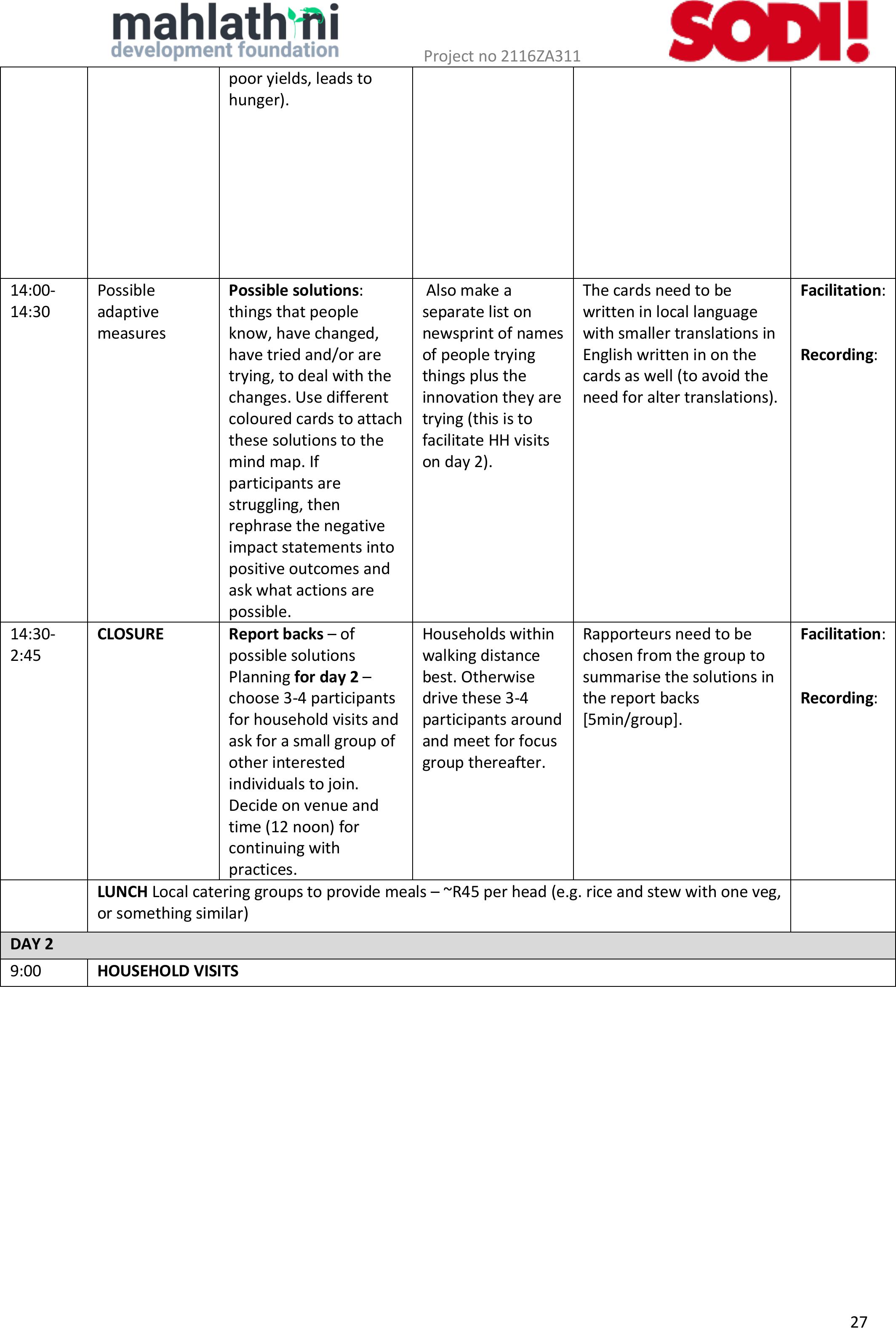
Project no 2116ZA311
27
poor yields, leads to
hunger).
14:00-
14:30
Possible
adaptive
measures
Possible solutions:
things thatpeople
know, have changed,
have tried and/or are
trying, to deal with the
changes. Use different
coloured cards to attach
these solutions to the
mind map. If
participants are
struggling, then
rephrase thenegative
impact statements into
positiveoutcomes and
ask what actions are
possible.
Also make a
separate list on
newsprintof names
of people trying
things plus the
innovation they are
trying (this is to
facilitate HHvisits
on day 2).
The cards need to be
written in local language
with smaller translations in
English written in on the
cards as well (to avoid the
need for alter translations).
Facilitation:
Recording:
14:30-
2:45
CLOSURE
Report backs – of
possible solutions
Planningfor day 2–
choose 3-4 participants
for household visits and
ask for a small group of
other interested
individuals to join.
Decide on venue and
time (12 noon) for
continuing with
practices.
Households within
walking distance
best. Otherwise
drive these 3-4
participants around
and meet for focus
group thereafter.
Rapporteursneed to be
chosen from the group to
summarise the solutions in
the report backs
[5min/group].
Facilitation:
Recording:
LUNCHLocal catering groups to provide meals – ~R45 per head (e.g. rice and stew with one veg,
or something similar)
DAY 2
9:00
HOUSEHOLD VISITS

Project no 2116ZA311
28
9:00-
12:00
Look at local
adaptations and
innovations.
Assess the household
situations. Start to
elucidate criteria people
use to make choices
and decisions.
Use questionnaire
and fillin through
semi-structured
interview and
observations.
Questionnaires to contain
the following info:
• Head of household
(male/female)
• No. of adults
• No. of children
(dependency ratio)
• Income sources
• Level of income
• Scale of operation; 0.10-1
ha, 1-2(5)ha, > 2 (5)ha
• Farming activities;
Aspirations – gardens,
fields, livestock,trees
• Market access
• Other activities
• Resources
• Water access
• Infrastructure
• Knowledge and skills
• Literacy rate
• Social organisation
Facilitation:
Recording:
Team meets in evening (before day 2)to discuss mind maps and lists of solutions and
choose a range of practices (5-10) from the database to present. Also, summarise criteria
that came from the household visit discussions.
TEA
Packed tea-to-gotoshare with household members
12:00
PRACTICES
12:00-
13:00
New ideas/
practices/
innovations
Recap and summary of
day 1. Introduce a
selection of new
practices – PowerPoint
and A4s (chosen the
night before by
facilitation team to
match the general
senseof what
participants need ideas
for or what they are
trying – to improve
upon those). Provide
descriptions and get
questions and
comments.
Selectthe 5-10
practices
beforehand and
make sure there
are 3-4 copies of
the A4s for the
small groups and or
a PowerPoint
presentation –
record comments
from participants.
Sets of practices (A 4s),
attendance registers
Materials
and
logistics:
Facilitation:
Recording:
13:00-
13:20
Criteria for
selection of
practices
In plenary present
criteria, discuss with
groupand add more
(prompt for criteria to
relate to five categories
(e.g. saving and using
water well, increasing
access to water,
improving organic
matter, increasing soil
health, increasing
natural resources, etc),
along with criteria like
Choose 5-7/8
criteria maximum.
Some criteriacan
be condensedfrom
two into one.
Flipchart, newsprint, kokis
Facilitation:
Recording:

Project no 2116ZA311
29
cost, labour, time, etc.
13:20 -
14:00
Prioritisation of
practices
Small groups:Choose a
selection of practices
from their own
suggestions and new
ideas presented (5-10)
and assess them using
the criteria chosen in a
matrix.
Let the group
decide for each
square using a
scale of 0-2 where
0 = “bad or ‘little”,
1= “OKto medium”
and 2 = “a lot to
good”.
Newsprint, kokis. Small
group facilitator and
recorder.
Facilitation:
Recording:
14:00
WAY FORWARD
14:00-
14:30
Each individual choses their practices. Set
up sessions in January to refine choices
and start on demonstrations and training
in implementation of practices and farmer
experimentation. Choose “volunteers” for
the fourproposedtunnels for joint/group
experimentation per site.
Learning sessions
Put together a list for each
small group for each
individual to record their
name, surname,
telephone/cell numberand
practices.
Facilitation:
Recording:
LUNCHLocal catering groups to provide meals –e. g. rice and stew with one veg, or something
similar
CLIMATE CHANGE PREDICTIONS:
Hotter
1-4 degrees Celsius
For every month of the
year
HIGH probability/certainty
Less rain
Similar amount of rain but over
a shorter period(fewer rainy
days per season)
This will lead to an
overall drying effect in
the environment
MEDIUM certainty
Greater intensity of rainfall
More rain in spring and/or more
rain in summer
Storms
LOW certainty
Longer term
Greater frequency of droughts under scenarios 1 and 2
Scenario 1 – businessas
usual. Scenario 2 – stabilise
emissions. Scenario 3 –
reduce emissions
Greater frequency of extreme rainfall events under
scenarios 1 and 2
Community-level climate change adaptation: Prioritisation and planningworkshop outline
DAY 2
Time
Activity
Process
Notes
Materials
Who
09:00
Introduction
09:00-10:00
Community and
team
introductions
In pairs, take fiveminutes
to talk to each other. Each
person names one
practice they know or are
doing that is good for CCA
– a CRApractice. OR, one
they would most like to try
out.
Practices to be
summarised on a
flip-chart.
Attendance
register – with
column for
CRApractices
– in English
and Zulu/Pedi.
Name tags,
stickers, kokis
Preparation:
Facilitation:
Recording:

Project no 2116ZA311
30
SAEON weather
predictions
Presentation and group
discussion on the SAEON
weather prediction maps
that are produced
quarterlyto ascertain
usefulness to farmers as a
decision-making tool.
Copies of the
temperature and
rainfall maps
produced for
each small group.
Preparation:
Facilitation:
Recording:
Purpose of the
day
Introduction of the
organisation/s and
purpose of this workshop
– review understanding of
CC, impacts and adaptive
measures. Introduction to
CRAprinciples.
Summarise from
report of 1st
workshop – use
the 5 categories –
summarise
measures under
each. Use two PP
slides attached.
Flip stand,
newsprint,
kokis, camera.
One person
undertakesto
take photos
throughout
the day. Extra
batteries for
camera and
sim card.
Preparation:
Facilitation:
Recording:
10:00
Prioritisation of practices
10:00- 11:00
Review practices
mentioned in
detail – both
community level
and presented
from one-pagers
Divide into small groups –
for prioritisation matrix.
Use five categories
(natural resources,soil,
water, crop, livestock).
Supply with cards where
all prioritised practises are
written. They prioritise
these in a list under each
category, based on what
to try first, second, etc –
make sure the criteria
used for these choices are
recorded. Returnto
plenary, present and get
overall choices
summarised for all small
groups.
See community-
level
prioritisation of
practices in excel
worksheet.
Flipchart
paper, kokis,
cards with all
prioritised
practices
written out,
prestick.
Preparation:
Facilitation:
Recording:
11:00-11:30
TEA
Fruit (apples, oranges, biscuits, juice and water, paper cups (lots)
and plates. Generous helpings, and lots of fruit juice if it is hot.
Find someone to take charge of food and refreshments, while
the rest of the workshop continues.
Preparation:
11:30
Demonstrations and learning
11:30-12:30
Learning and
practical
demonstration
session on a
selection of
practices – start
with gardening
practices
(appropriate for
present season)
Presentation to group –
discussions, etc, then
practical demonstrations
in an appropriate garden –
preferably a household
garden. Choose 1-4
practices, e.g.trench bed,
mulching, liquid manure,
intercropping.
Facilitators to come prepared with
handouts and learning materials.
Also, materials for doing the
practical demonstrations such as
mulch, manure, seed, seedlings,
tools, and other, e.g. shade netting,
poles, gravel and ash for tower
gardens – depends on practices
and must be planned for.
Preparation:
Facilitation:
Recording:
14:30
Individual experimentation
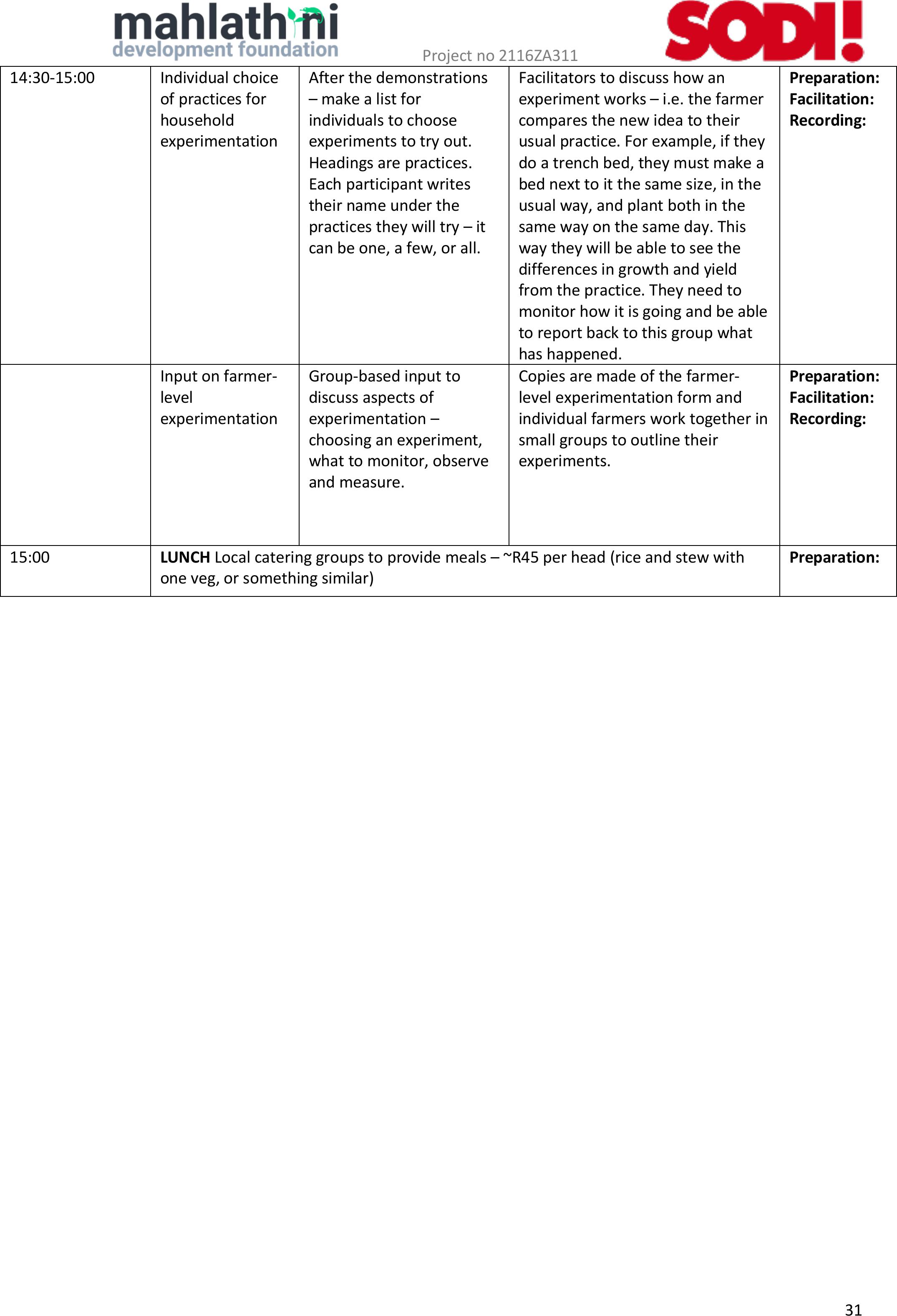
Project no 2116ZA311
31
14:30-15:00
Individual choice
of practices for
household
experimentation
After the demonstrations
– makea list for
individualsto choose
experiments to try out.
Headings are practices.
Each participant writes
their name under the
practices they will try – it
can be one, afew, or all.
Facilitators to discuss how an
experiment works – i.e. the farmer
compares the new idea to their
usual practice. For example, ifthey
do a trench bed, theymustmake a
bed nextto it the same size, in the
usualway, and plant both in the
sameway on the same day. This
way theywill be able to see the
differences in growth and yield
from the practice.Theyneed to
monitor how it is going and be able
to report back to this group what
has happened.
Preparation:
Facilitation:
Recording:
Input on farmer-
level
experimentation
Group-based input to
discuss aspects of
experimentation –
choosing an experiment,
what to monitor, observe
and measure.
Copies are made of the farmer-
level experimentation form and
individual farmers work together in
small groups to outline their
experiments.
Preparation:
Facilitation:
Recording:
15:00
LUNCH Local catering groups to provide meals – ~R45 per head (rice and stew with
one veg, or something similar)
Preparation: